| |
Presenting one of the world’s greatest artistic
traditions, Masterpieces of Chinese Painting 700 -
1900 was a once-in-a-lifetime chance to see rare
surviving works of art drawn from collections around
the world. It featured over 70 of the finest
examples of Chinese painting, from small-scale
intimate works by monks and literati through to a
14-metre-long scroll painting, many of which were
shown together for the first time.
Charting the evolving styles and subjects of
painting over a 1200 year period, the exhibition
included figure paintings on silk for religious
sites, landscape painting and the introduction of
Western influences. A significant number of these
masterpieces had never been exhibited before, from
banners, albums and scrolls created for a variety of
settings to the materials that reveal the
traditional process and techniques of painting on
silk. |
 |
Victoria and
Albert Museum
The World’s Greatest Museum of
Art and Design
Cromwell Road
London, England
Tuesday - January 14th, 2014
Green Dragon Society
Attended Exhibit
|
|
Ancient Chinese and Western Art have
a crucial difference. The purpose of Western Art was
relating a tale, which is why it depended on a high
degree of realism. Early Chinese Art could not
depend on realism, as ceremonial objects used in
religious or sacrificial rites involving communion
with spirits and ancestors, needed to be decorated
with more imagination. This provided an aura of
mystery and inspired a sense of awe. Objects
connected with ritual influenced the Chinese sense
of aesthetics and realism was not revered. The
“Literati” (learned men, monks and scholars)
considered they were painting the meaning of a
subject, not the reality which they saw but this
idea became less important when outside influences
arrived on the Chinese art scene. |
|
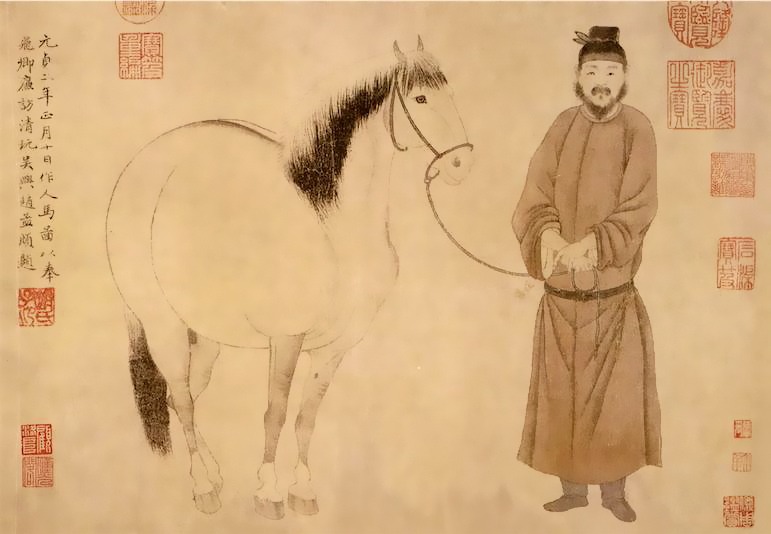 |
|
In the West we have long understood our own Art
History but in China categorisation of their
wonderful art is a new concept. Differences in
techniques of painting in China and the West are
important. Western artists mixed their pigments with
oil which gave the effect of translucency. The
Chinese used water based paint and made use of
mineral pigment, e.g. azurite for blue and malachite
for green. The Chinese also paid great attention to
surfaces and texture, often using silk, which also
served as currency. There is an academic controversy
as to whether embroidery was the fount of Chinese
Art; the 'Literati 'probably thought otherwise! |
|
 |
 |
| Hongxing Zhang, Senior Curator of the Chinese
Collection at the V&A, and curator of this
Exhibition, said his aim was, “To help build a
bridge between Chinese Art and the world outside by
finding a language common to us all. This is what
China needs and this is what I can do to meet this
need.” The Exhibition covers 1,200 years of Chinese
painting and is displayed in themes. It was a
daunting task and the preparation took four years of
negotiations with several Chinese Museums and the
present Chinese Government. There has not been such
a display since the end of the First World War. |
The finest examples of Chinese painting are show
cased in this splendid Exhibition from the beginning
of the 8th century. These range from small scale
personal works by ‘Literati’ to scroll paintings,
some over 14 metres long. The viewer can see how
styles and subjects evolved over the years, through
banners, albums and scrolls; and the figure
paintings on silk and landscapes are impressive. The
Chinese Artists loved nature and painted it in great
detail.
The first theme of the Exhibition is called ‘Objects
of Devotion’ (700-950). Several Buddhist banners and
screens are displayed and there are non-Buddhist
works too. The illustrated manuscript showing the
five planets and twenty eight constellations
attributed to Zhang Sengyou is one of the earliest
hand scrolls showing astrological deities. This
theme is followed by ‘The Quest for Reality’ which
deals with a major change in subject matter and
style, portraying a growing interest in the natural
world between 950 and 1250. Landscapes, mountains,
rivers and changing weather and light all appear;
they are simply delightful and Yan Wengui’s Landscape
with Pavilions is especially charming. One work
depicts a lonely bullock cart struggling up a cliff
face - very evocative of the struggle of life.The theme ‘Embracing Solitude’ (1250-1400) displays
many striking innovations. Monks and Scholars
introduced calligraphy and poetry to their works,
not work for commission but for private display. Do
not miss Wang Mian's Snow at Broken Bridge. The
early plum symbolises purity and endurance under
adversity. The next theme is the ‘Pursuit of
Happiness’ (1400-1600); a boom period for artists
with work much in demand. 'The Four Pleasures' is
wonderful, a series showing the learned pursuits,
calligraphy, painting, music and chess. |
 |
| ‘Challenging the Past and Looking to the West’
(1600-1900) is the final theme. It is divided into
two parts. The first looks at competition between
artists and how they competed with their
predecessors and contemporaries. They were
passionate and saw themselves as heirs to the grand
tradition of Chinese painting. Bada Shenren’s
Flowers on the River is a good example from this
period; a painting 14 metres in length and so
intricate. Finally, ‘Looking West’ deals with the
impact of Western painting on China. The West had
mastered linear perspective and chiaroscuro, and
perspective can be seen in the court painter, Xu
Yang's Prosperous Suzhoo (1759) which depicts
bustling city life. |
|
Green Dragon
Society Field Trip - January 14th, 2014 |
| There are three main systems of belief in China:
Taoism, Buddhism and Confucianism. Chinese people
did not adhere strictly to one religion. They
carried out the religious observance most
appropriate to the occasion, finding that the three
religions complemented rather than contradicted each
other. Many objects, whatever religion they are
ascribed to, share the same symbolic motifs, and
Buddhist and Taoist temples were similar in many
respects. This is typical of the inter-relatedness
of the different forms of Chinese worship. |
|
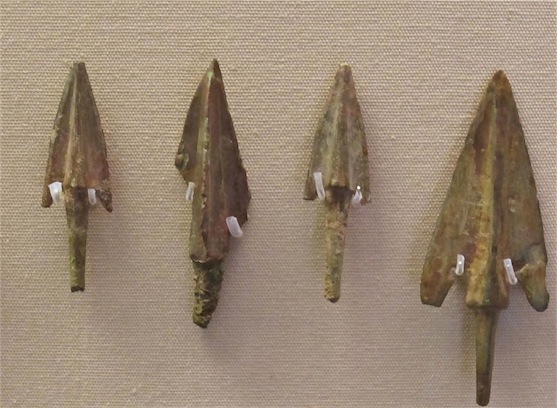
Bronze Age
Arrowheads |
|
|
 |
|
January 31st, 2014 - Lunar Calendar
New Year
Year of the Horse
Chinese Year 4712 |
|
Millions of people across China, Korea, Vietnam,
Japan and other countries around the world are celebrating the Lunar New
Year |
|
These
performers, dressed in costumes of the Qing Dynasty, are performing the
ancient royal heaven worshipping ceremony. The sacred ceremony was
performed by emperors throughout history in Beijing to pray for the
peace and prosperity of the nation. |
|
Offerings of Flowers & Fruits
beautifully decorate the Altars at Chanh Giac Tu Temple on Chinese New
Years |
|
 |
 |

Won Kow Reataurant
2237 S. Wentworth Ave
Chicago - Chinatown
312-842-7500
9 a.m. to 11 p.m. Sunday-Thursday
9 a.m. to midnight Friday and Saturday
Established: 1928
Won Kow is the oldest continuously operated restaurant in Chicago's
Chinatown
Saturday - February 1st, 2014
Green Dragon Society
Lunar New Year Dinner
|
|
Nineteenth Century Victorian Martial
Art |
|
Bartitsu is called many things: the lost martial
art of Sherlock Holmes, the West’s first mixed martial art, the
Victorian science of self-defense. It was devised by Edward William
Barton-Wright, a globe-trotting child of the empire, in the late 1890s,
who promised that a confident exponent could make light work of any
ruffian, armed or otherwise. |
|
LIVE: THE HISTORY OF BARTITSU
MARTIAL ART OF SHERLOCK HOLMES
The Idler Academy
81 Westbourne Park Road, London
Tel 0207 221 5908
Thursday - February 27th, 2014
Drinks at 6.30pm - Lecture/Demonstration at 7pm
Green Dragon Society
Attended Demonstration
The talk and
demonstration was given by James Garvey
He has been studying and teaching Jiu Jitsu for nearly 20 years
He is Secretary of the Royal Institute of Philosophy
He is editor of The Philosophers Magazine |
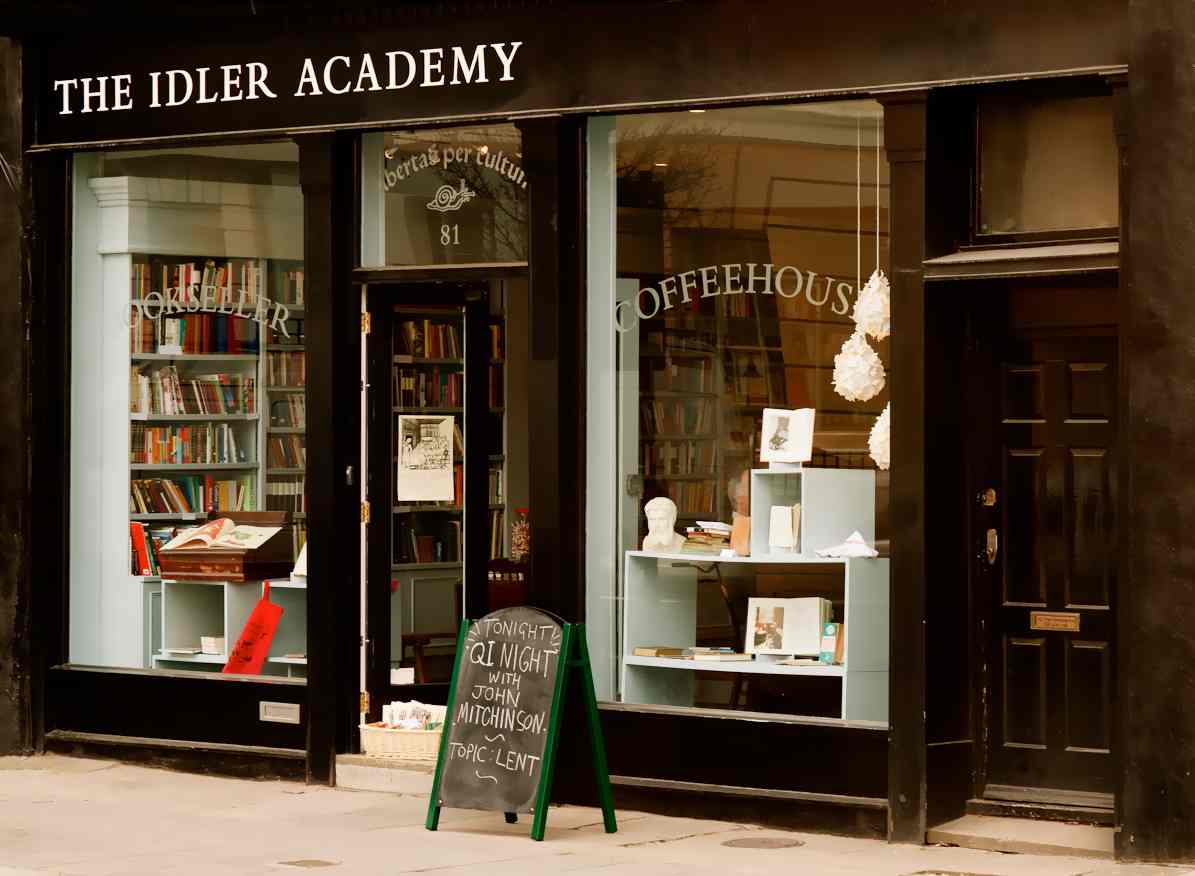 |
|
It is a blend of Jiu-Jitsu, Wrestling and good old
fashioned ‘Boxing’. Bartitsu was all about using whatever you had to
hand. |
|
‘This was the West’s first mixed martial art,’
explains instructor James, at an Idler Academy Bartitsu class held in a
UCL gym. ‘It was about out-thinking your opponent. You can see why it
appealed to a Victorian sensibility.’ You certainly can.
Then it’s time for ‘the Coat Defense’: we drape a coat
over a shoulder, before launching it into the face of an approaching
assailant and wrestling them to the floor.
Victorian ninjaesque ass-kicking self-defense: sounds
made up, no? Googling doesn’t help, as all the images of the long lost
nineteenth-century technique of Bartitsu look like a storyboard for an
Armstrong and Miller sketch. Bowler-hatted gents loft canes at each
other like samurai swords. Tweed overcoats are slung as though they’re
man-snaring gladiatorial nets. And as for the name? Its inventor, called
Edward William Barton-Wright, took ‘Ju-Jitsu’ and merged it with his
surname. |
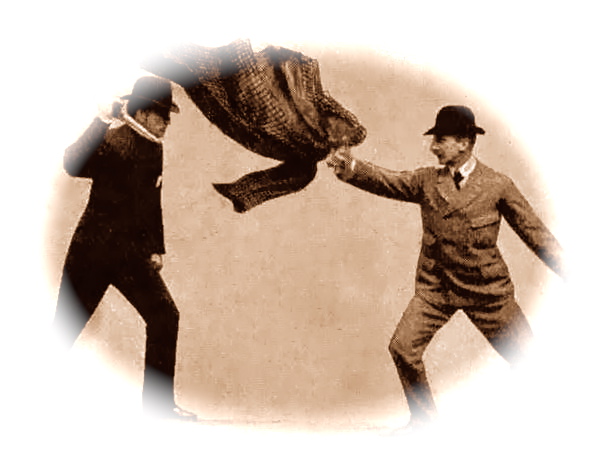 |
| This is the story of how it came about, what it is, how it was
nearly lost, and the worldwide Bartitsu revival currently underway.
Taking in fighting French dock workers, Japanese wrestlers, garroting
gangs, Victorian hooligans, Jiu Jitsu suffragettes, masters of cane
fighting, all-in wrestling tournaments, self defense with a parasol, and
a typo made by Arthur Conan Doyle, the story of Bartitsu is sometimes
surprising, but always most edifying. The talk will include a
demonstration of Bartitsu, where you will learn how to remove a
troublesome man from a room, defend yourself with an umbrella, and use
an attacker’s momentum against him. |
|
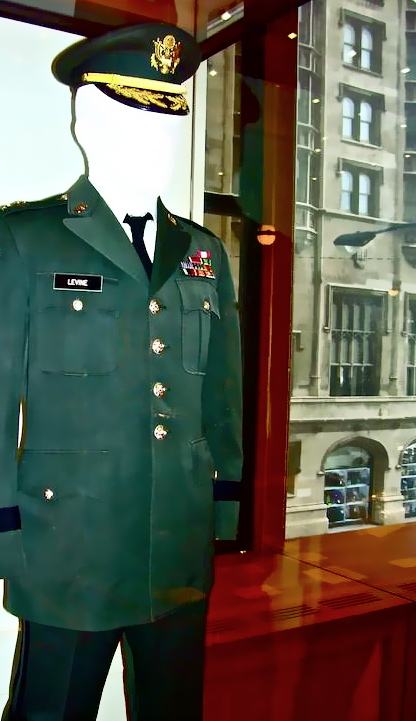 |
 |
|
Consisting of more than 40,000
volumes, the Pritzker Military Museum & Library’s book collection is
made up of titles spanning all periods of history, countries,
cultures/peoples, and branches of the U.S. military. |
|
1914 Postcard - Chicago Michigan Ave
at Monroe St - The Monroe Building |
|
The Historic Monroe Building in
Chicago
104 S. Michigan Ave.,
Chicago, IL 60603
Home of the
Pritzker Military History Library/Museum
Thursday - March 13th, 2014
Green Dragon Society
Research Field Trip
Library Book Sale Event
The Monroe Building now houses the Pritzker Military Museum & Library on
floors two through four
Dedicated to the story of the Citizen Soldier in American history
The Museum & Library is open to the public with a
collection of books and gallery exhibits
With live events in a two-story lecture hall and broadcast center
|
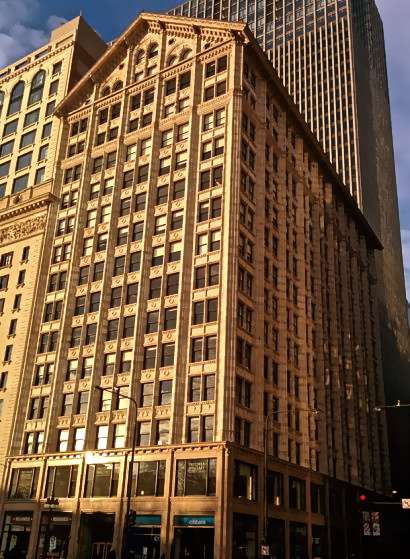
Monroe Building Today |
|

Monroe Building - Michigan Ave Entrance
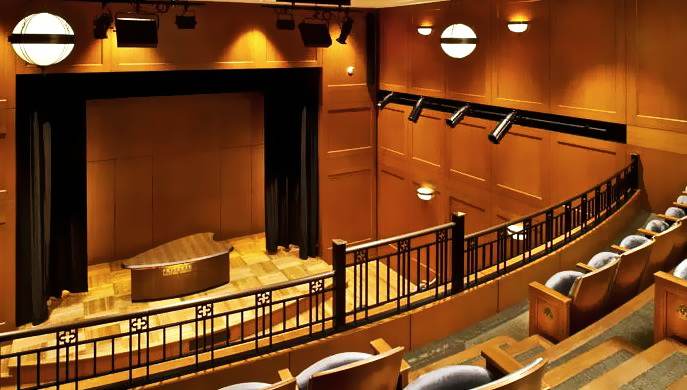 |
 |
|
Lecture Hall - Broadcast Center |
Monroe Building Romanesque Lobby |
|
Designed by Martin Roche, this 1912,
Romanesque-inspired, 16-story steel frame building, is clad in a
combination of terra cotta and granite. |
| The restoration of the building’s
interiors includes the restoration and recreation of original design
elements including Rookwood tile floors, walls and vaults, decorative
iron elevator grilles, doors and hardware, and lighting fixtures.
Restoration of historic elements was informed by surviving original
construction documents, early photographs, and much extant historic
material retrieved from the site. |
|
Pritzker Military Library |
|
Wargaming |
Original Oil Painting |
|
American Icons of the Great War
Exhibit |
Drawn exclusively from the Pritzker Military Museum & Library’s
extensive collections of posters and other printed material, the
six-part, 27-image exhibition tells the story of the role that art and
artists played in persuading everyone in America, not only the men in
uniform, to join the fight for victory.
World War I was the first American conflict in which the government made
extensive use of images, in the form of posters, placards, and other
materials, to recruit troops and rally home support for the war effort.
Some of the best-known and most recognizable commercial artists in the
nation, including Howard Chandler Christy, James Montgomery Flagg,
Sidney Reisenberg, John E. Sheridan, Vincent Aderente, Douglas Volk, and
Victor Clyde Forsythe, lent their talents to the initiative. Many of
these artists were already well-known to the American reading
public—their work had appeared in such popular publications of the time
as Scribner’s, Scientific American, Everybody’s Magazine, Leslie’s
Magazine, and the Hearst newspapers.
The war effort gave rise to some of the most enduring and compelling
images in America’s history, including the now-famous images of Uncle
Sam, the “Doughboy” soldier, as well as images once famous and now less
well known like the Spirit of Columbia. These images are now an
important part of the visual American identity. |
|
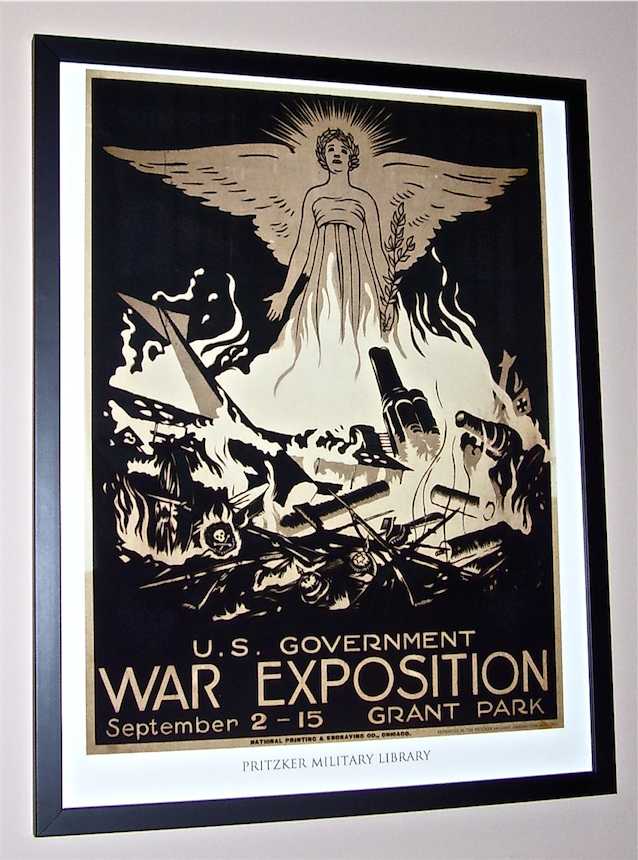 |
 |
|
 |
 |
|
 |
|
The Crossing: The 132nd Infantry
Regiment on Guadalcanal
Original Oil Painting by James Dietz
This 2013 painting is prominently displayed near
the Museum & Library's entrance.
It was commissioned to document the role of the Illinois National Guard
in the pivotal Battle of Guadalcanal. |
|
Breaking the Harlange Pocket - Original Painting |
M1 Girand Rifle Bayonet . . . circa 1943 |
|
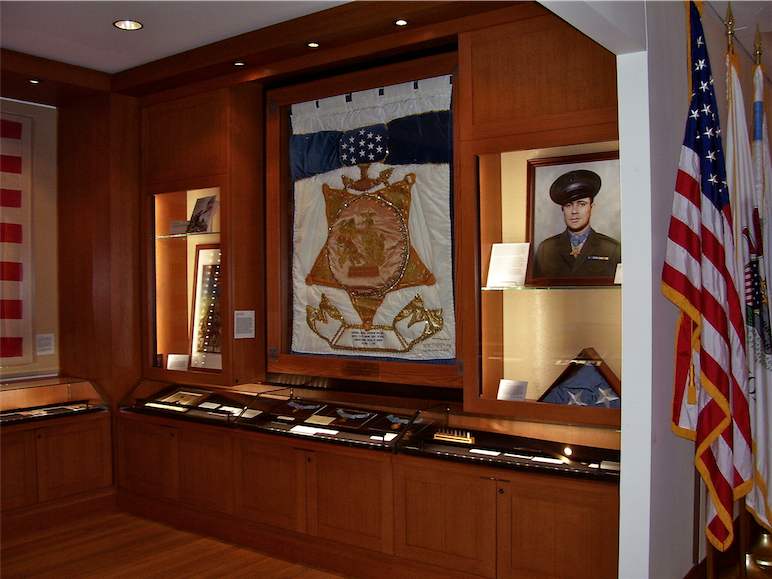 |
|
 |
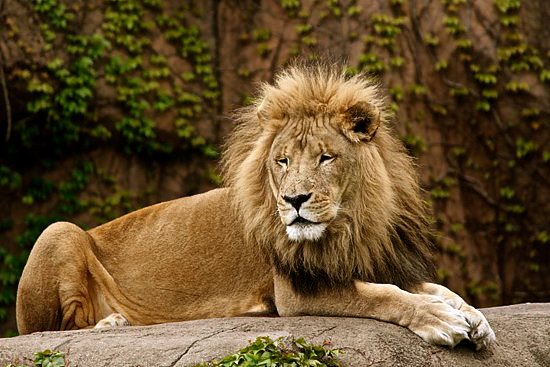 |
|
Lincoln Park is the
largest park in Chicago. Long and narrow, it begins at North Avenue
and follows along the banks of Lake Michigan for quite a number of
miles. Within its 1,200 acres, is a wealth of things to see and do.
Lincoln Park Zoo is a 35-acre world of
wildlife in the shadow of skyscrapers. Located within a verdant park
just minutes north of downtown Chicago, the zoo has been a natural, free
oasis for generations of animal lovers, who visit the zoo to hear a
lion’s roar echo off nearby apartment buildings, see gorillas climb
trees as the Willis Tower looms in the distance, or forget where they
are as they immerse themselves in tropical rainforests, dry-thorn
forests or spacious savannas.
A premier Chicago attraction, Lincoln Park Zoo each year
welcomes more than three million visitors. Its intimate setting enables
guests, young and old alike, to experience for instance, the thrill of
gazing directly into the eyes of a lowland gorilla. Famous also for its
historical structures, the zoo has succeeded at combining
state-of-the-art animal and visitor facilities with beautiful
architectural reflections of past times and sensibilities. Although it
is among the oldest zoological gardens in the country, it also is among
the most modern leader in wildlife conservation, community education and
recreation. |
 |
Lincoln Park Zoo
Just minutes north of downtown Chicago
Lincoln Park Zoo is located off Lake Shore Drive at the Fullerton
Parkway exit
The Zoo is open 365 days a year and only closes in
instances of severe weather
Hours depend on the season of the year
Thursday - April 24th, 2014
Green Dragon Society
Field Trip
Study the Animals
Drawing visitors to the heart of Chicago's north
side for 135 years, Lincoln Park Zoo is one of the oldest and most
popular zoos in America |
|
Zoo Pond - Paddle Boat rentals
available |
|
| History - Lincoln Park Zoo was
established in 1868 when New York's Central Park Commissioners sent the
Lincoln Park Commissioners the gift of two pairs of swans. The swans
were such a popular attraction that the park commissioners began
acquiring other animals and building quarters for them, adding a bear
cage, a bison enclosure, a sea lion pool, an eagle exhibit, and an
animal house, all before 1900. Although the zoo was initially conceived
as a primarily recreational attraction, its mission has evolved over
time, with conservation, science, and education now forming central
elements. Starting in 1884, when the zoo saw what was reportedly the
first-ever birth of a North American Bison in captivity, Lincoln Park
Zoo has been part of the effort to study and protect endangered species
from all over the world. |
|
Lion House - Today
Today the cats have some access to a natural outdoor
roaming area |
Lion House - Early 20th Century (post card)
In the past, the outdoor access was just another cage |
| Lion House - Built in 1912, the Kovler
Lion House stands as a handsome historical landmark at the heart of the
zoo. Inside, its wide hall and vaulted ceiling richly amplify the roars
of some of the worlds rarest and most beautiful big cats, including
African Lions, Siberian Tigers, Leopards from Asia and Africa, Jaguars
from South America, and Snow Leopards of the Himalayas. |
|
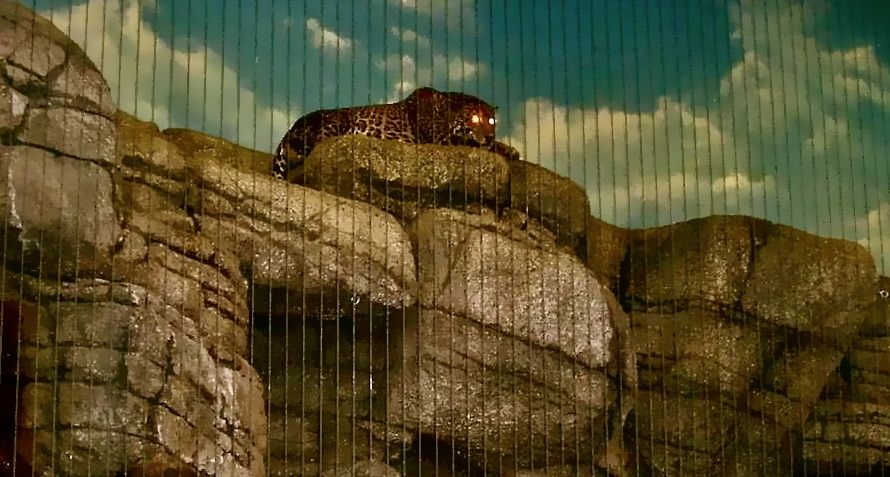 |
From the brightly colored red-ruffed lemur to the tiny emperor
tamarin, primates of all shapes, sizes and colors can be seen swinging
and bounding through the trees inside the Helen Brach Primate House.
Originally opened in 1927, the historic Primate House once was lined
with small, sterile cages typical of the first zoos. However, a two-year
renovation of the buildings interior, completed in 1993, created eight,
naturalistic exhibits that replicate the native habitats of the primates
that make their home at Lincoln Park Zoo today. A large outdoor habitat
provides additional play space for howler monkeys during the warmer
months. |
|
Black-and-white Colobus Monkeys live
in troops of as many as nine individuals. Their home range is about 40
acres, including a preferred area from which other groups are chased
|
The Western Lowland Gorilla is the
largest of the living primates. Males can be up to 6 feet tall and 400
pounds. They have black to brown-gray coats that turn gray with age |
| Birds from the tropics, seashores, forests, wetlands and savannas
all have room to roost in Lincoln Park Zoos McCormick Bird House. Within
this historic, brick building (designed in 1904 by the zoos first
director, Cyrus DeVry), are 10 habitats replicating the dense jungles,
sandy coasts, running streams and grassy plains of the birds natural
homes. |
|
Spotted Hyenas are powerfully built
predators. They have massive necks and large heads. Their jaws are
probably the strongest in relation to size of any mammal. Spotted Hyenas
measure 3–5 feet and weigh 100–150 pounds |
Africa’s smallest and most colorful
swine species, Red River Hogs (Wild Boars) have reddish bodies with a
white stripe running down the back. Both sexes have tusks. Adults can
reach up to 5 feet in length and weigh up to 285 pounds |
|
The largest land-based predators on
Earth, Polar Bears can reach up to 8 feet long and 1700 pounds in weight |
Pygmy Hippopotamuses can reach six
feet in length and weigh up to 600 pounds |
|
Souvenir Pictures: taken for sale to
visitors - 1897 to 1924 |
|
Middle Eastern Restaurant on the
Northside of Chicago |
|
Authentic Persian food that reflects heritage.
Ingredients are always fresh, most of the spices come from Iran, and the
menu is prepared using treasured family recipes. The restaurant ambiance
is quiet, and softly lit, the walls and alcoves decorated with exquisite
Persian tiles depicting Sufi fables and tales. Melodious Persian music
accompanies patrons as they enjoy the food and each other's company.
|
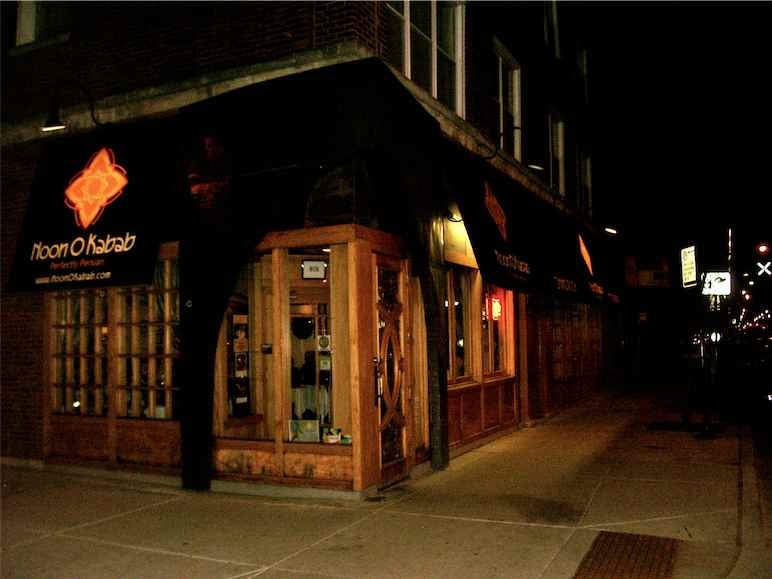 |
Noon O Kabab Restaurant
4661 N. Kedzie Ave.
Chicago IL 60625
(773) 279-9309
Monday - Thursday: 11am-10pm
Friday - Saturday: 11am-11pm
Sunday: 11am-9pm
Located in the heart of Chicago's historic Albany Park on
the Northside of the city, right across the street from the CTA Brown
Line Kedzie station and have ample street parking.
Saturday - May 3rd, 2014
Green Dragon Society
Members Reunion: Dinner |
Persian History - The Fertile Crescent
is the region in the Middle East which curves, like a quarter-moon
shape, within what was once the Persian Empire. It is the common
designation for this region and the Fertile Crescent is traditionally
associated (in Jewish, Christian and Muslim faiths) with the earthly
location of the Garden of Eden.
Known as the "Cradle of Civilization", the Fertile Crescent is
regarded as the birthplace of agriculture, urbanization, writing, trade,
science, history and organized religion and was first populated in
10,000 BC when agriculture and the domestication of animals began in the
region. By 9,000 BC the cultivation of wild grains and cereals was
wide-spread and, by 5000 BC, irrigation of agricultural crops was fully
developed. By 4500 BC the cultivation of wool-bearing sheep was
practiced widely. Some of the earliest beer in the world was brewed in
the great cities along the Tigris and Euphrates Rivers.
In their religion the Persians had no temples, altars or images of gods.
But they did climb the highest mountains and offer sacrifices to Zeus.
They also worshipped the sun, moon, earth, fire, water and winds. And
they worshipped Mitra too.
Persia is noted in western history as the foe of the Greek city states
during the Greco-Persian Wars, and for emancipation of slaves including
the Jews from their Babylonian captivity, and for instituting the usage
of official languages throughout its territories. The empire had a
centralized, bureaucratic administration under the Emperor and a large
professional army, inspiring similar developments in later empires. |
|
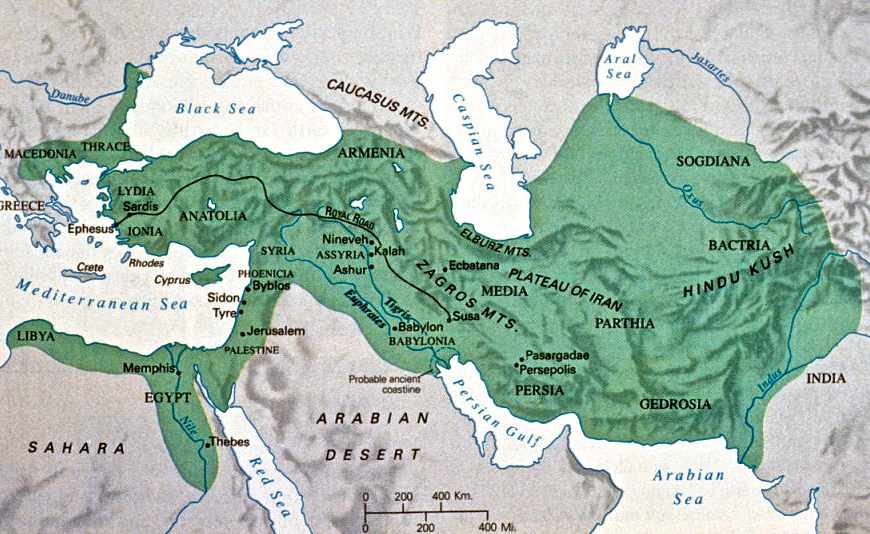 |
|
Persian Empire at its' Peak . . . in
490 BC |
| The Persian Empire was the largest empire by geographical extent in
ancient times. The empire spanned three continents: Asia, Africa and
Europe. At its greatest extent, the empire included the modern
territories of Iran, Afghanistan, Pakistan, parts of Central Asia, Asia
Minor, Thrace and Macedonia, much of the Black Sea coastal regions,
Iraq, northern Saudi Arabia, Jordan, Israel, Lebanon, Syria, and all
significant population centers of ancient Egypt as far west as Libya. |
|
T'ien Hau
Taoist Temple - China Town Los Angeles |
|
This Los Angeles Chinatown Temple is one of 1,000
temples worldwide dedicated to the Goddess Mazu. While the “mother”
temple is in Fukian province of China, smaller temples can be found in
many areas in the south of Vietnam, southern China, and wherever peoples
from these regions have settled, including Los Angeles. |
|
The original building of the Temple
was formerly a Christian church. It was purchased in the 1980s and
transformed into a small Taoist Temple. Blessed with a strong
faith-based community in and outside of Chinatown Los Angeles, the
Temple was able to raise enough funds with which to build a larger
Temple. After two years of building, the new temple was
completed in September 2005. |
|
T'ien Hau Temple - Los Angeles
750-756 N. Yale St.
Los Angeles, CA 90012
(213) 680-1860
Tuesday - May 6th, 2014
Green Dragon Society
Visited Temple
$2 million was raised to build the new temple, with many
specific parts (such as columns and doors) being donated by wealthy
individuals. Most of the masonry, ceiling, and decorative art was
crafted in China and assembled on site. The columns are made from a
single granite stone, but are reinforced with steel inside as required
by our earthquake codes |
 |
A ceremonial drum and bell can be seen hanging next to the massive
columns at the temple’s entrance. The front doors represent the
traditional door guard deities, and on the sides one can find the gods
of the four directions. Inside the temple are panels carved of pure
granite representing dragons (on the right wall) and tigers (on the left
wall).
Note the stone Fu dogs at the front entrance of the temple. Also the
ceremonial urn which traditionally was used by villagers to pray for
good weather (thus its location outside the temple). Many people ask
about the stone horse. It is said that children who crawl under it are
protected from harm. |
|
 |
The Goddess Mazu, also spelled Matsu,
Tin Hou in Cantonese, Thien Hau in Vietnamese; is the indigenous goddess
of the sea who protects fisherman and sailors, and is invoked as the
goddess who protects East Asians who are associated with the ocean. Her
mortal name is Lin Moniang. She is widely worshiped in the south-eastern
coastal areas of China and neighboring areas, especially Zhejiang,
Fujian, Taiwan, Guangdong, and Vietnam, all of which have strong
sea-faring traditions, as well as migrant communities elsewhere with
sizable populations from these areas.
According to the legend, Lin Moniang was born in 960 as the seventh
daughter of Lin Yuan on Meizhou Island, Fujian. She did not cry when she
was born, and hence her given name means “Silent Girl”. According to
legend, Lin Moniang’s father and brothers were fisherman. She wore red
garments while standing on the shore to guide fishing boats home, even
in the most dangerous and harsh weather. After her death, the families
of many fisherman and sailors began to pray in her honor of her acts of
courage in trying to save those at sea.
Mazu is usually depicted wearing a red robe in paintings or murals, but
in sculpture is clothed in the robes of an empress holding a ceremonial
tablet and wearing the easily recognized flat-topped imperial cap with
hanging beads front and back. Mazu is usually depicted together with two
guardian Generals.
Her believers come to the temple to worship her with food offerings,
incense offerings, and donations. To ask a question, they shake a can of
sticks to see what number stick(s) falls out, and then consult slips of
yellow papers arranged on the wall that decipher the number into a
message. |
|
 |
|
Deities at the Main Altar |
The figure on the right is Guang Gong (Kuan Ti), the God of
War and the protector of the Heavens. He is always shown with a red face
and a spear at hand. He is also the deity associated with money. The
figure in the middle is Mazu, the goddess and protector of
fishermen and coastline areas. The figure on the left is Fu De,
the Earth Deity and the deity associated with actions and deeds.
Underneath the main altar is a niche with a Tiger. People born in
the year of the current astrological sign make offerings--particularly
of meat--to the tiger to encourage him to “eat” or destroy any evil or
negativity associated with their sign.
On both sides of the sanctuary are niches holding replicas of the
goddess inscribed with the names of deceased individuals or living
families. It is believed that those named receive blessings by virtue of
their proximity to the altars. Food offerings in the way of fruit,
cooking oil, bags of rice, etc. are collected by the temple and used in
cooking (primarily vegetarian) meals for the poor on temple feast days.
A list of dates is printed and circulated in the community so that
people know they can come and receive a free meal on those days.
Incense is available on a complimentary basis at the temple because
individuals donate it believing that if someone uses their incense to
worship the goddess, they will receive blessings too. If one wants to
make sure that the goddess knows it is he/she that is worshipping, one
should either bring one’s own incense, or pay for whatever incense used,
paying as much or as little as one wishes. |
|
 |
|
Side Chapel for Deceased - The gallery to the
right of the main temple is dedicated to ancestors. When someone in the
community dies, a table is set up to the side of the altar with a photo
of the deceased, offerings and incense. This remains in place for 10
days before being taken down. Then, one can purchase a miniature red
headstone/plaque and inscribe it with the name of the deceased. It is
placed behind the altar in one of the many niches.
The deity figure here is Kuan Yin, to the Taoists a female "Goddess of
Mercy", and to the Buddhists, a male "Deity of Mercy". She is a figure
universally recognized and worshiped by Taoists and Buddhists. |
| Other Chinatown Temples - Los Angeles Chinatown is home to
six temples. In addition to these, most of the family associations have
ancestral shrines that are sometimes confused with temples. |
|
Since 1949 - the Zen
Buddhist Temple of Chicago
Carrying on the traditions of our
founder Soyu Matsuoka Roshi (Abbott from 1949 to 1971)
and Kongo Langlois Roshi (Abbott from 1971 to 1999)
Helping people work to realize their inherent wisdom
and compassion through Zen meditation and Dharma teachings
We continue to offer the Buddha's Teaching to all beings
To quote Takashina Rosen, primate of the Soto
Zen sect
“Think that which cannot be thought - think nothing”
|
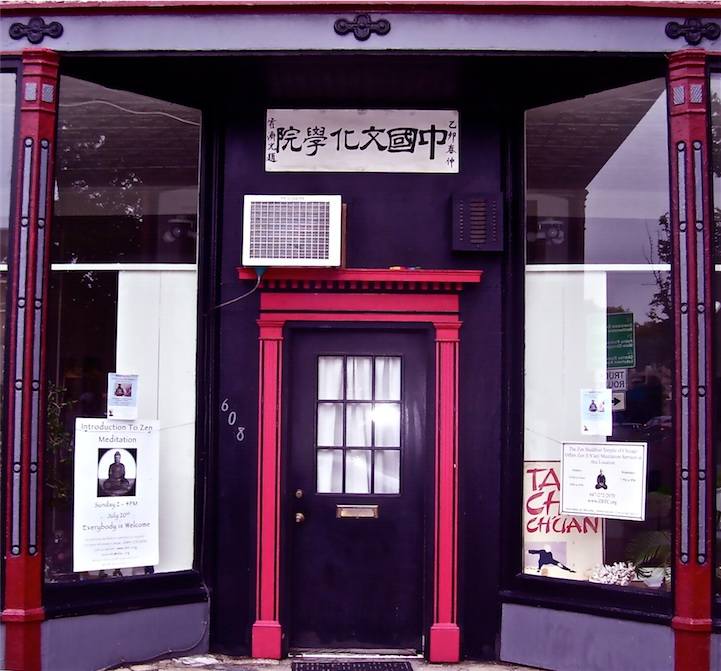 |
Zen Buddhist Temple of
Chicago
608 Dempster Street
Evanston, Illinois
847 272-2070
The Temple's mailing address is:
P.O. Box 176
Northbrook, Illinois 60062
Wednesday - June 25th, 2014
Green Dragon Society
Attended Zazen Meditation
The Zen Buddhist Temple of Chicago was founded in 1949 by
Soyu Matsuoka Roshi. Originally located on Halsted Street on the north
side of Chicago, the Temple moved to its current location in the 1980s.
We also share space with the Chinese Cultural Academy, which offers
classes in Tai Chi Chuan. |
The Zen Buddhist Temple of Chicago is a Soto Zen Temple
dedicated to helping practitioners realize their true nature through
Zazen, seated meditation. Zen Buddhists hold that all living beings are
pure Buddha nature that seems to be obscured by the workings of the
discursive mind, fueled by the pressures of modern life. Through daily
practice of seated meditation, we allow the discursive mind to settle,
and let this true nature be expressed in our daily life.
Buddhism is non-theistic. The historical Buddha is not worshipped as a
deity, but rather serves as an example of the realization that is
expressed through our Zazen practice. Practitioners of other faiths may
cultivate themselves through Zazen, supplementing their existing
spiritual practice.
Throughout the year we celebrate various Zen Buddhist Holidays |
|
Altar - Zen Buddhist Temple of
Chicago |
| The mind should be a perfect observer, like a shiny mirror,
reflecting everything perfectly but never marred by the reflection.
Watch the rise and fall of the breath from moment to moment. During
Zazen the mind is used for observing, not thinking. Look inwardly at
your state of mind before any thought arises. When a thought arises, cut
it off and get back to the work. What work? Looking inwardly at your
state of mind before any thought arises. Whenever you find that you are
thinking, daydreaming or in some manner following a chain of thoughts
during Zazen, immediately cut off the thoughts, and bring your awareness
back. |
|
Zen Buddhist Temple Guardians |
Imperial Dragon |
|
By Professor Linrothe at the Zen
Buddhist Temple of Chicago |
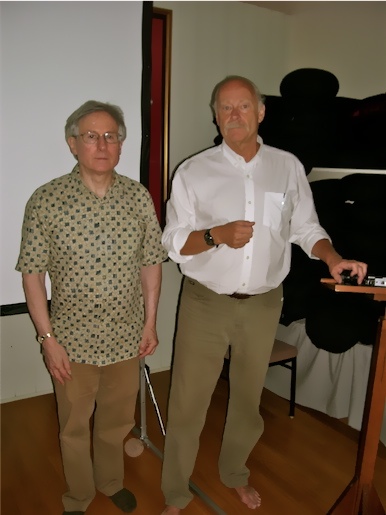 |
Zen Buddhist Temple of
Chicago
608 Dempster Street
Evanston, Illinois
847 272-2070
The Temple's mailing address is:
P.O. Box 176
Northbrook, Illinois 60062
Saturday - June 28th, 2014
Green Dragon Society
Attended Lecture
The form of Buddhism nearest in nature to the Taoist
philosophy
within the Art of Chi Tao, practiced & taught by the Green Dragon
Society,
is Chinese Ch'an (Zen in Japan)
Zen practice permits an understanding and realization
of the deeper and more subtle aspects of our lives
and points toward a compassionate and more confident way of living
"However inexhaustible my delusions are
I vow to extinguish them all" |
|
Professor Linrothe (Right) |
|
|
Lecture and Slideshow by Professor
Rob Linrothe
The professor has been traveling to India and Tibet for decades.
His field trips are across the high deserts of the Himalayan Mountains.
His guides are not from some travel agency.
His photos of mountains, monasteries and indigenous mammals are
inspired.
His lecture conveyed the "feel" of the Himalayas and the ancient
Buddhists.
His historical knowledge of the Buddhist religious artifacts is
impressive.
His understanding of the culture ethnographically comes from personal
experience. |
|
After the lecture the Green Dragon
Society instructors and students proceeded to the Siam Pasta Restaurant,
down the block, for some Thai food. The second floor has a balcony open
to the outside and it was a beautiful day. |
|
Field Museum of Natural History -
Field Trip |
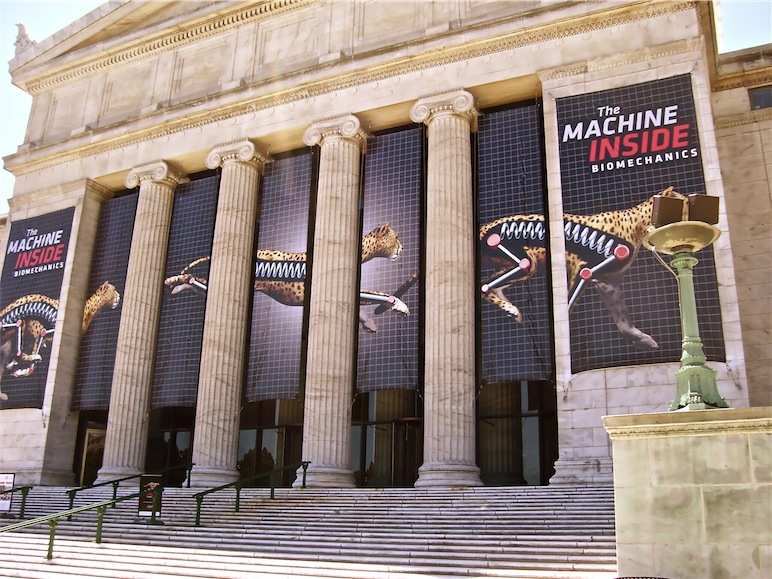 |
Field Museum of
Natural History
Chicago
1400 S. Lake Shore Dr.
Chicago, IL 60605
Hours: 9am - 5pm
Open every day except Christmas
Friday - July 4th, 2014
Green Dragon Society
Field Trip |
Fish that can project their jaws out to half their body lengths to
capture prey? Spider webs stronger than steel? Discover the marvels of
natural engineering—and see how we can apply the innovations of
evolution.
Highly interactive and specimen-rich, this timely, hands-on, and fun
exhibition brings the amazing science of biomechanics to life, and
explores the exciting promise it holds for the future.
By scientists who investigate these plants and animals, experiment with
new adaptations and applications, and learn about the future of
biomechanics and biomimicry, fields that are re-energizing the
imaginations of architects, engineers, and designers alike. |
|
D3D Cinema and The Field Museum
present 'Titans of the Ice Age 3D' |
| In this exciting 3D adventure, discover an icy world on the brink of
extinction, where humans share the frozen tundra with majestic beasts.
Encounter some of the Earth’s most awe-inspiring mammals, from
saber-toothed cats and dire wolves to giant sloths and the iconic
mammoths that lived 10,000-years before modern civilization. Explore the
life and behavior of Lyuba, a 40,000-year old female woolly mammoth calf
recently exposed by the melting Siberian permafrost. And meet our
ancient ancestors who were developing art, language, and hunting skills
as they sought to understand and survive in the harsh world around them.
Titans of the Ice Age 3D is an unforgettable journey back in time that
you won’t want to miss, only at The Field Museum. |
|
 |
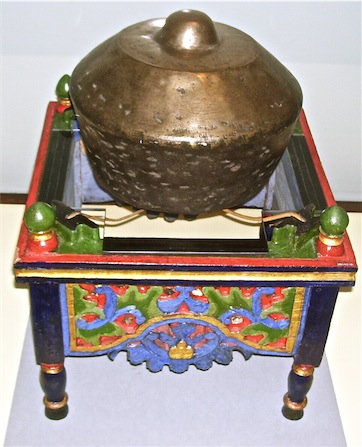 |
Luring millions to Chicago in 1893, the World’s Columbian Exposition
was a glittering showcase of architecture, culture, technology, and
peoples from around the world. Not only the birthplace of the Juicy
Fruit chewing gum and the Ferris Wheel, the World’s Fair also marked the
triumphant debut of our very own Field Museum.
Now, 120 years later, the Museum is opening its hidden collections to
display incredible artifacts and specimens that will bring to life one
of the most spectacular events in the Windy City’s history in Opening
the Vaults: Wonders of the 1893 World’s Fair. Get a look at objects
that have rarely—or never—been on display since they amazed fairgoers
over a hundred years ago, including a meteorite so feared it was kept
chained in a dungeon.
Explore how the fair brought visitors closer than ever to unique wonders
like exotic animals, international cultures, and strange new products
from all over the world. And see how Field Museum scientists continue
to conduct ground-breaking research on the ever-growing collection using
new technology. |
|
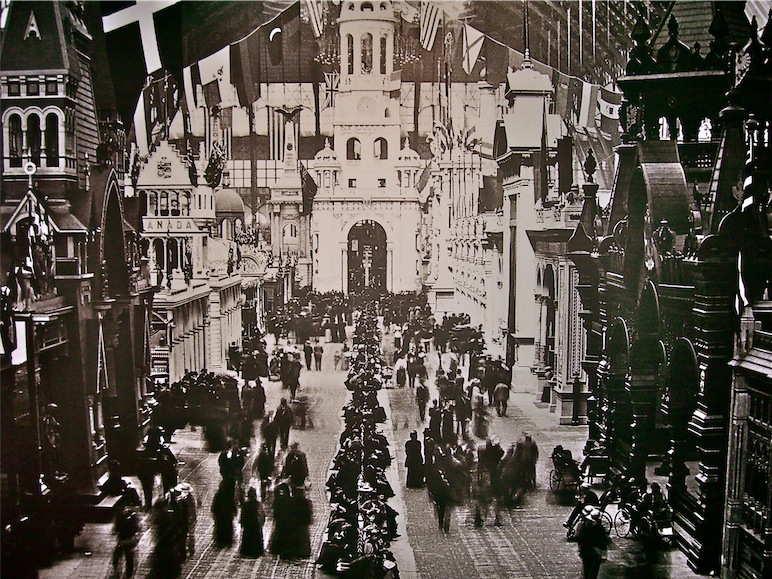 |
|
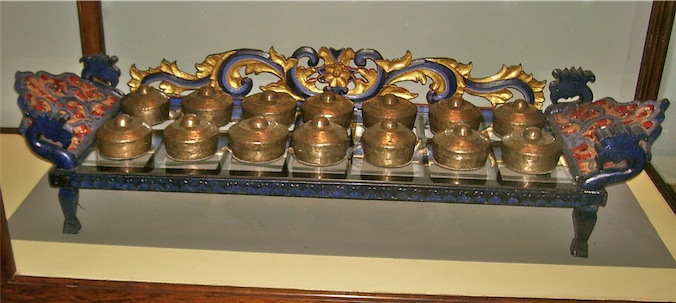
Dragon Money Boat
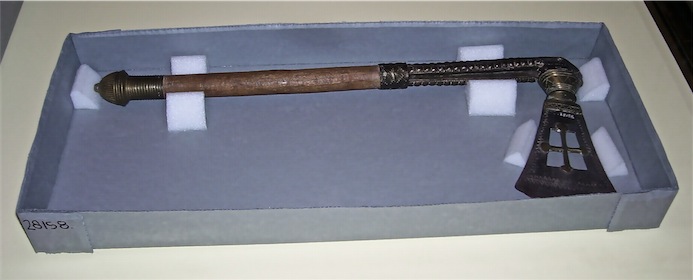
Fighting Axe |
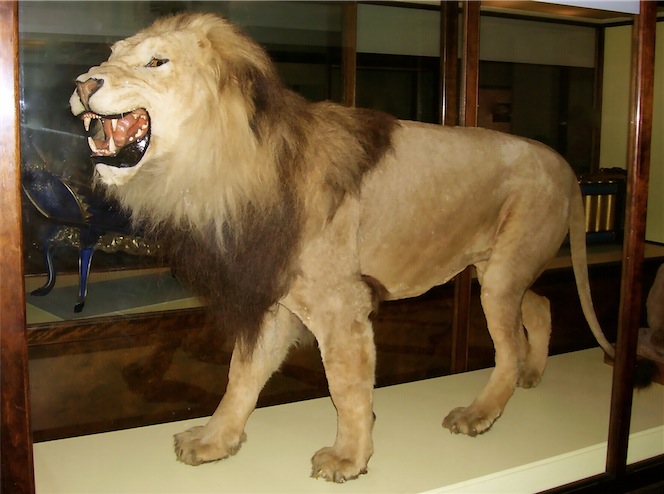
Lion |
|
Field Museum - Animal Exhibits |
|
Tibetan Buddhism Celebration for the
Goddess of Mercy |
|
She Who Hears the Cries of the World |
|
One of the stories surrounding Kuan
Yin is that she was a Buddhist who through great love and sacrifice
during life, had earned the right to enter Paradise after death. However,
while standing before the gates of Paradise she heard a cry of anguish
from the earth below. Turning back to earth, she renounced her reward of
bliss eternal but in its place found immortality in the hearts of the
suffering |
|
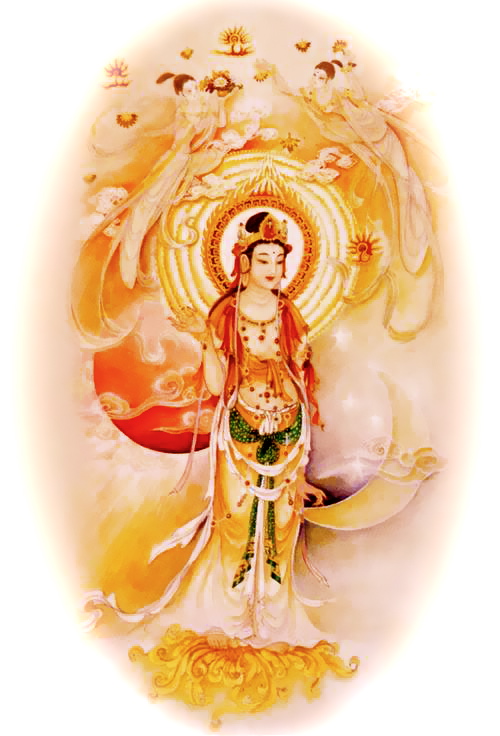 |
Goddess of Mercy
Celebration
Presented by
Ling Shen Ching Tzu
1035 W 31st Street,
Chicago, IL 60608
773-927-8807
Chicago
South Side - Chinatown
Chinatown Square Mall
Sunday - July 6th, 2014
Green Dragon Society
Members Attended |
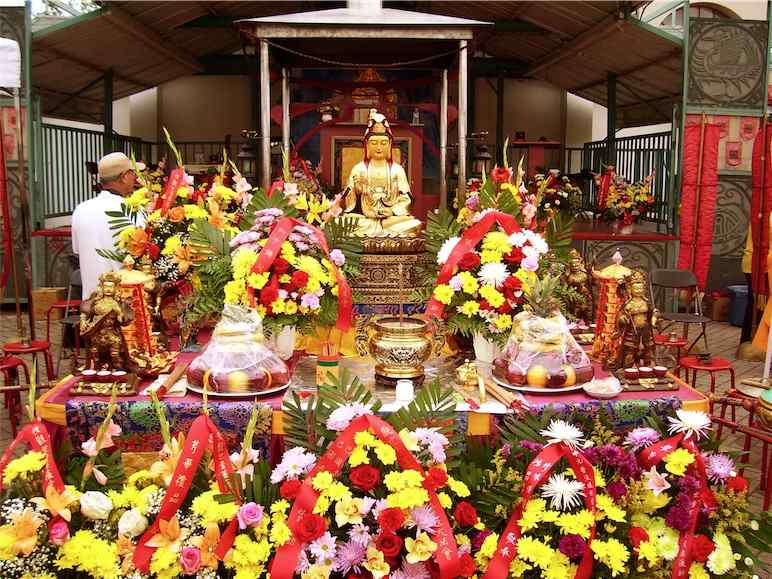 |
|
Mantra
OM MANI PADME HUM
'Hail to the Jewel in the Lotus' |
|
Kwan Yin protects those who call upon her from
danger. While the festivals of most gods are accompanied by the sound of
firecrackers to scare away evil spirits, this is not necessary in the
case of Kwan Yin, as no evil spirit would dare approach her. |
|
The Great Vehicle is a state of mind
that is realized by practicing compassion for all sentient beings. It’s
described as a vast boat that carries all beings in the universe across
the sea of suffering. The practice of this mantra allows one to enter
directly into the awakened state of mind.
There is the clean and clear wealth. It is devoid of the depraved energy
that can be attached to money. This is the ‘Pure Wealth’ - the wealth of
higher consciousness. |
|
Procession |
Blessing Offerings |
|
Kuan Yin’s themes are Children, Kindness, Magic,
Health and Fertility.
Her symbols are a Lotus, Black Tea, Rice and Rainbows.
Kwan Yin is the most beloved of all Eastern Goddess figures.
Giving freely Her unending Sympathy, Fertility, Health and Magical
Insight to all who ask. |
|
Chinese Traditional Dance |
Festival Children |
|
Martial Arts - External Style |
Martial Arts - Internal Style |
|
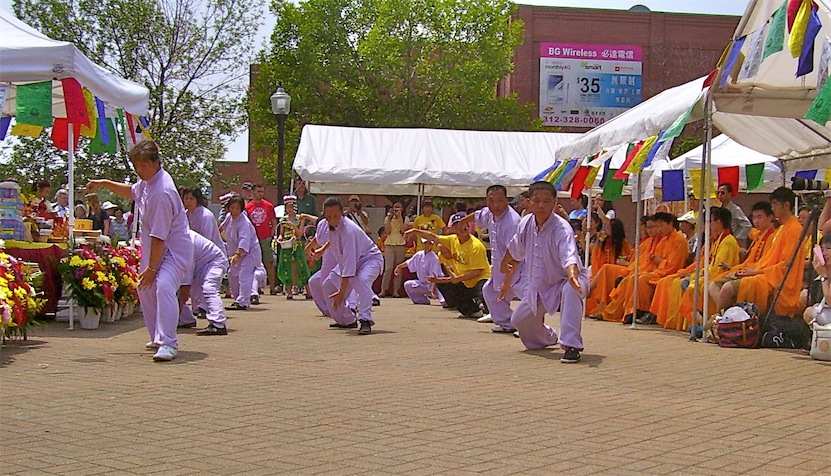 |
|
The first major exhibition to present the origins,
history and practice of a millennium of visual history, Bodies in
Balance explores the guiding principles of the Tibetan science of
healing represented in medical paintings, manuscripts, and medical
instruments. A multi-media installation shows how Tibetan medicine is
used today. The exhibition invites visitors to relate what they discover
to their own lives through interactive experiences within the galleries
and throughout the Museum. |
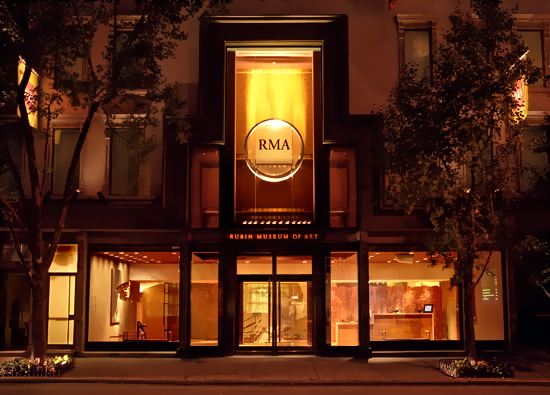 |
The Rubin Museum of Art
150 W. 17 St., NYC 10011
Located in the Chelsea neighborhood of New York City
on 17th Street between 6th and 7th Avenues
212 620-5000
The Art of Tibetan Medicine Exhibition
Wednesday - July 16th, 2014
Green Drsagon Society
Field Trip
|
|
Tibetan Herbs and Spices for Health |
|
The Rubin Museum of Art is home to a comprehensive
collection of art from the Himalayas and surrounding regions. The
artistic heritage of this vast and culturally varied area of the world
remains relatively obscure. Through changing exhibitions and an array of
engaging public programs, the museum offers opportunities to explore the
artistic legacy of the Himalayan region and to appreciate its place in
the context of world cultures.
The museum's collection consists of paintings, sculptures, and textiles.
Although works of art range in date over two millennia, most reflect
major periods and schools of Himalayan art from the twelfth century
onward. |
|
Curated by Theresia Hofer
The Rubin Museum of Art is a fascinating museum with a permanent
collection that moves visitors to think about health and spirituality,
community, and ways of living and being. It also has rotating exhibits,
such as an exciting one on Tibetan
Medicine–Bodies in Balance: The Art of Tibetan Medicine.
The Rubin Museum is hosting a special course, Nutritional Health and
Happiness. In the Tibetan tradition foods, herbs, and spices have
powerful effects on physical and mental well-being. This course explores the
nutritional wisdom of the Himalayan region and teaches how to
incorporate such knowledge into your own life.
The relationship of Tibetan medicine, Buddhism, and the visual arts
has been integral to the development and transmission of this medical
tradition. Approximately 140 objects dating from the 9th century to the
present day demonstrate the advancement of Tibetan medical knowledge as
it was codified in medical texts, illustrated in art, demonstrated by
medical tools, and made evident by examples of medicines compounded from
natural ingredients and applied in practice.
Bodies in Balance provides audiences an opportunity to have a
personalized exhibition experience. The Tibetan science of healing is
based on an analytical system in which three forces - wind, bile, and
phlegm - govern physical and mental aspects of being. |
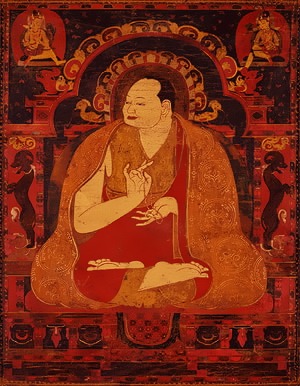 |
|
Using a brief
questionnaire, visitors can determine which of the three forces is
dominant in their constitutions and follow a color-coded pathway that
highlights the exhibition components most relevant to them. The
exhibition includes videos and a touch screen that provide additional
information and interactive experiences of select elements of these
practices. |
|
Tibetan Medicine Buddha (Bhaishajyaguru) |
Assorted Tibetan Medical Tools |
|
Modern Tibetan Medicinals |
Daka Earth Spirit |
|
Tibetan Herbal Apothecary |
Tibetan Medical/Magical Diagrams |
|
Ancient Tibetan Medical Manuscripts |
|
Tibetan - Various Spoons and Bloodletting
Instruments w/Implement Container |
|
Ancient Tibetan - Bone Setting Manuscript |
|
Old Tibetan Medical Book |
Ancient Tibetan - Herbal Illustrated Manuscript |
|
India East Exhibit - Rubin Museum of
Art |
|
|
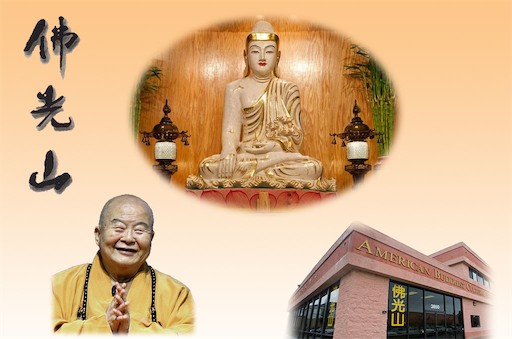 |
 |
|
Fo Guang Shan - "Buddha's Light
Mountain"
An International Chinese Mahayana Buddhist Monastic Order
that has gained a Worldwide Presence, with Chapters Around the World
The Headquarters of Fo Guang Shan, located in Kaohsiung, Taiwan is the
largest Buddhist Monastery in Taiwan
The organization itself is also one of the largest charity organizations
in Taiwan |
|
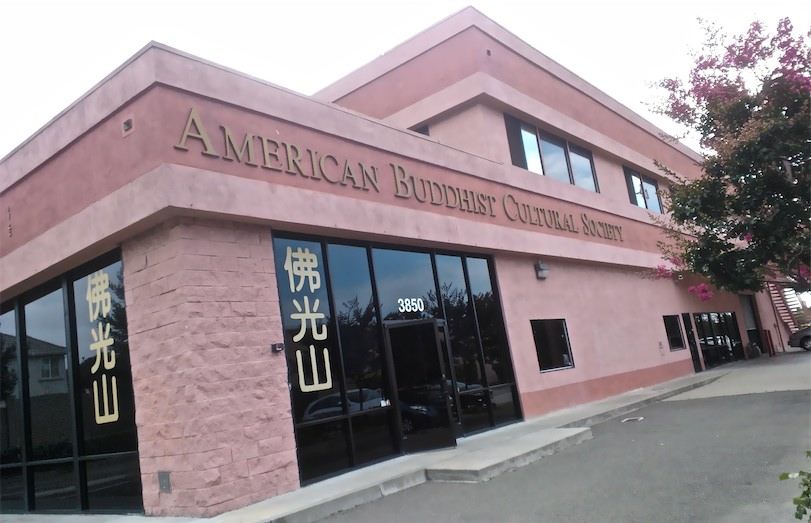 |
American Buddhist Cultural Society
Fo Guang Shan Fremont Temple
3850 Decoto Road
Fremont, California, 94555
Telephone: (510) 818-0077
Sunday - July 20th, 2014
Green Dragon Society
Visited Temple
Attended Services
Fo Guang Shan was founded in Taiwan, in 1967, by
Venerable Master Hsing Yun, a renowned Chinese Buddhist monk and
scholar. The order promotes Humanistic Buddhism, a modern Chinese
Buddhist philosophy developed through the 20th Century, and made popular
by this and other modern Chinese Buddhist orders. Humanistic Buddhism
aims to make Buddhism relevant in the world and in peoples lives and
hearts. |
|
American Buddhist Cultural Society -
Fremont, California .
. . Altar Room |
|
Founded by Master Hsing Yun in 1967, Fo Guang Shan
has Evolved from a Mountaintop Bamboo Forest to the Largest Buddhist
Monastery in Taiwan |
|
Taiwanese Fo Guang Shan
Monastery
153 Xingtian Road
Dashu Disrict, Kaohsiung
Taiwan 84010
At the north-east of Dashu Township in Kaohsiung
county on the left bank of the Gaoping (Kaoping) river, a famous
destination is located. Here you will find the Buddhist center of South
Taiwan, established by Master Hsing Yun and his disciples.
The architecture of the temples is very characteristic, and at the
southeastern side of Fo Gunag Mountain (Gunag Shan) Monastery the most
prominent landmark of the region is found: a huge golden statue of
Buddha Amitaabha which measures some 120 meters. The main square is
surrounded by 480 standing Buddha's, while water and mountains form the
magnificent scenery. |
 |
| The main structures consist of four temples, namely the Daxiongbao, the Dabei, the |
Buddha Amitaabha (120 meters) |
| Dazhi and the Dashu shrines. The Daxiongbao shrine covers a
large area and is the most imposing of all four shrines. The main god of
worship here is Sakyamuni, while statues of Amitaabha is placed on the
left and right sides. More than 10,000 Kuan Yin statues surround the
temple. Buddha statues and lanterns of light rest in the 14,800 holes in
the walls of the four shrines. The site counts more than a thousand
Buddha statues, large and small. |
|
Main Sanctuary - Fo Guang Shan Monastery, Taiwan |
Fo Guang Shan - Interior Main Sanctuary |
|
Chinatown - Summer Street Fair 2014 |
|
 |
35th Annual Chinatown Summer Fair
Wentworth from Cermak to 24th Place
Neighborhood Festival featuring: A Dragon and Lion Dance procession.
Asian cultural entertainment and live music.
A taste of Chinatown’s many restaurants, local unique gift shops,
Chinese arts and crafts.
Street vendors with an array of merchandise and a children’s area for a
day long family event. |
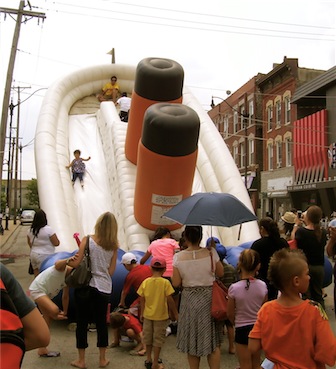 |
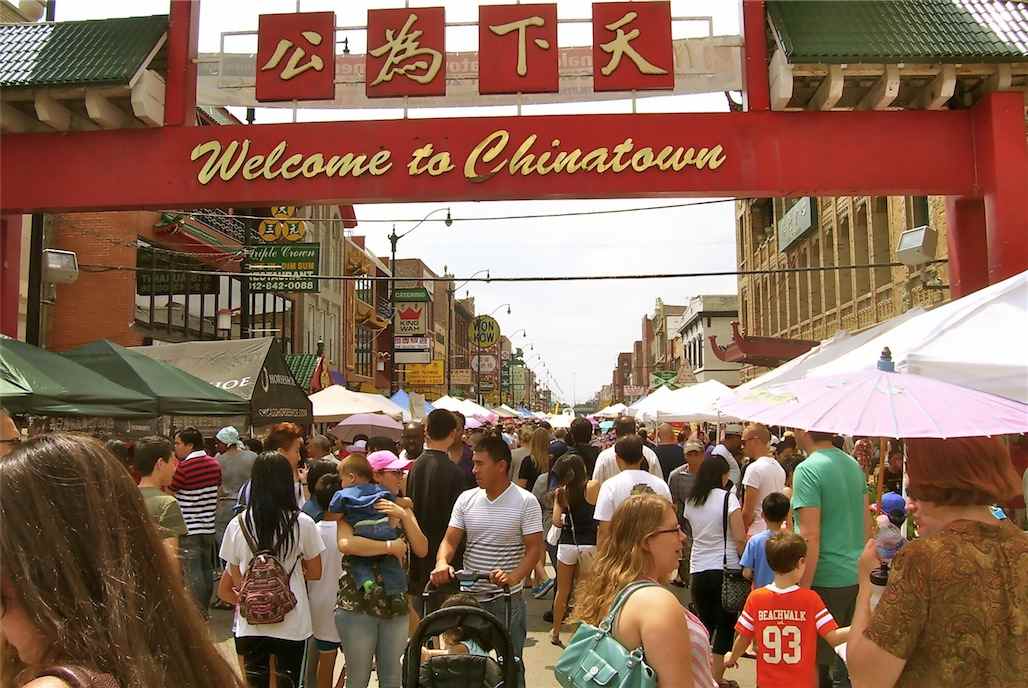 |
Chinatown Summer Fair
by
Chicago Chinatown Special Events Committee
Sunday - July 20th, 2014
Green Dragon Society
Attended Fair
Annual Celebration of Far East Culture
Includes the Dragon & Lion Dance Procession
Artisans, Food Vendors and More
Celebration of Chinese Culture at this Chinatown Event,
with many Varieties Chinese Food, Original Art and Music from the Orient |
|
Main Stage (23rd St. & Wentworth Ave.) |
Speaker: Illinois Secretary of State Jesse White |
|
Musical Entertainment (Song: House of the Rising
Sun) |
|
Kuan Yin Alter_Ling Shen Ching Tzu |
Flowers & Plants |
|
Lecture - by Professor Wallach at
the Zen Buddhist Temple of Chicago |
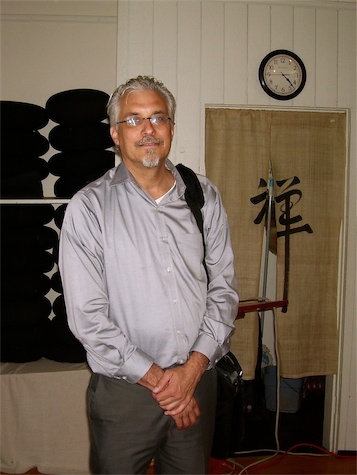 |
Zen Buddhist Temple of
Chicago
608 Dempster Street
Evanston, Illinois
847 272-2070
The Temple's mailing address is:
P.O. Box 176
Northbrook, Illinois 60062
Saturday - July 26th, 2014
Green Dragon Society
Attended Lecture
Northwestern University Professor Harlan Wallach
Engaged in the digitization, preservation and online publication of
cultural heritage and humanities projects around the world. He works in
the area of digital culture, humanities and publications, for both local
and international initiatives. He has worked extensively in Asia with
the Dunhuang Academy and the Shaanxi Cultural Heritage &
Preservation Institute, been engaged with the Andrew Mellon
Foundation, and a broad range of University based e-culture
initiatives. |
|
Professor Wallach |
Dunhuang
Project |
| ProfessorWallach was the technical lead for the Mellon
International Dunhuang Project and the project primary investigator
for three other initiatives, working with the Cultural Relics Bureau
of China, including imaging Shuilu'an, conducted with the
Shaanxi Cultural Preservation group. This project ran from 2005 to 2008
and involved the very high resolution digital image capture of the free
standing Great Buddha Hall at the Temple of Shuilu’an China, in Lantian,
Sha’anxi Province. With support from The Andrew W. Mellon
Foundation, Northwestern University undertook a collaborative
project to document Shuilu'an Temple with high-resolution digital
imagery, including 3-D capture. Project partners included Northwestern
University Academic and Research Technologies Advanced Media Production
Studio, the Shaanxi Provincial Wenwuiju (Cultural Relics Bureau),
and the Dunhuang Research Academy. |
|
Ancient Sites on the
Silk Road - Dunhuang, Mogao Grottoes |
| The Mogao Grottoes, a World Heritage Site near the town of
Dunhuang in western China, are located on the edge of the Gobi Desert,
along the ancient caravan routes---collectively known as the Silk
Road---that once linked China with the West. Founded by Buddhist monks
as an isolated monastery in the late fourth century, Mogao grew
gradually over the following millennium, as monks, local rulers, and
travelers carved hundreds of cave temples into a mile-long rock cliff,
and adorned them with vibrant murals portraying episodes from Buddhist
scripture, luxuriant portraits of Silk Road rulers, and richly detailed
scenes of everyday life. The Mogao caves developed into a spiritual and
artistic mecca whose renown extended from the Chinese capitals to the
far western reaches of Central Asia. Today there remain more than 490
grottoes, the walls of which are decorated with some 45,000 square
meters of wall paintings, making Mogao one of the world's most
significant sites of Buddhist art. |
|
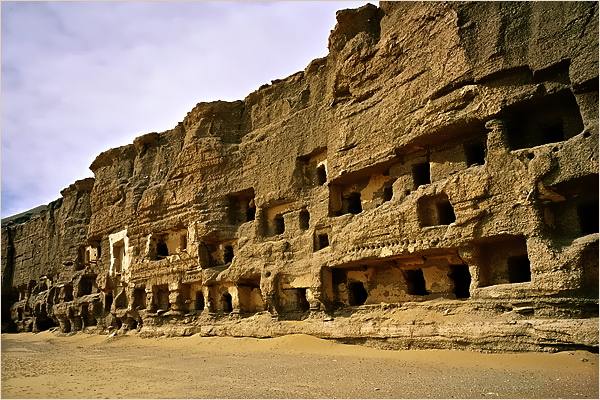 |
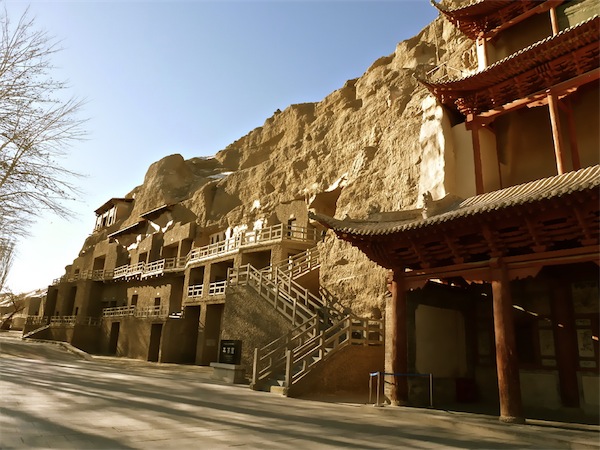 |
|
Caves of Dunhuang |
Caves of Dunhuang Modern Restoration |
|
Arsenal Island - Rock Island,
Illinois |
|
Rock Island Arsenal Garrison is located on an
island in the Mississippi River between Iowa and Illinois
The Illinois island is almost a mile wide, three miles long and has 946
acres
Rock Island Arsenal Garrison is our nation's largest government owned
and operated arsenal
This center is the Army's only fully integrated metal manufacturing
facility and the only remaining U.S. Army foundry
In 1969, the arsenal was placed on the National Register of Historic
Places
In 1989, the original arsenal buildings were designated a National
Historic Landmark |
|
National Historical Landmark
Building |
|
Rock Island Arsenal
Garrison
Joint Munitions Command
Joint Manufacturing and Technology Center
U.S. Army Corps of Engineers, Rock Island District
U.S. Army Sustainment Command
First United States Army
Tuesday - July 29th, 2014
Green Dragon Society
Field Trip |
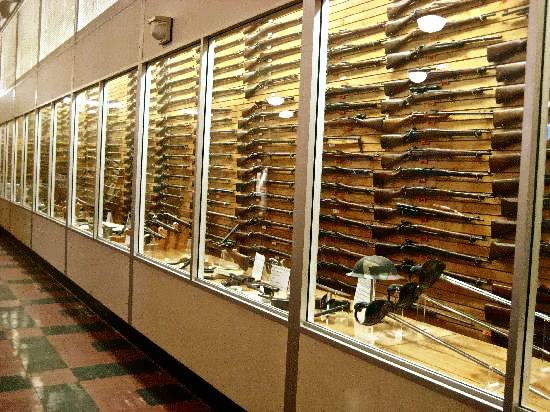 |
|
History - Rock Island Arsenal |
| Under the provisions of the 1783 Treaty of Paris which ended the
American Revolutionary War, the British ceded to the United States a
huge western tract of land. known as the Northwest Territory. The
territory included the present states of Illinois, Indiana, Michigan,
Ohio, Wisconsin, and part of Minnesota. The British government in
Canada, acting in its own interest, agreed to supply arms and ammunition
to Indian leaders such as Tecumseh, who formed an Indian confederacy to
counter the encroachments of American traders and settlers into the
Northwest. The noted Sauk warrior, Black Hawk, was among the braves that
joined the confederacy. As American settlers advanced through the
frontier of the Northwest, they defeated the confederacy at Fallen
Timbers, Ohio, in 1794 and at Tippecanoe Creek in 1811. |
| In dealing with the Indians of the Northwest Territory, the United
States Government established the precedence of negotiating formal
treaties with the Indians to gain possession of land they occupied.
These treaties defined and redefined boundary lines between advancing
white settlements and retreating Indian Tribes. In many of the treaties,
provisions were added to establish forts at strategic locations within
the newly drawn boundaries of the Indian territory. This chain of events
formed a scenario which was repeated as the American frontier advanced
through the Northwest territory. The United States acquired title to the island in 1804 through a
treaty with the Sauk and Mesquakie Tribes. President Thomas Jefferson
instructed the Governor of the Indian Territory, William Henry Harrison,
to acquire Indian lands which adjoined the Mississippi River and its
tributaries. Harrison, later the ninth President of the United States,
made an effort to obtain Indian land cessions. Through bribery, liquor,
and threats, he seized every opportunity to “negotiate” land away. |
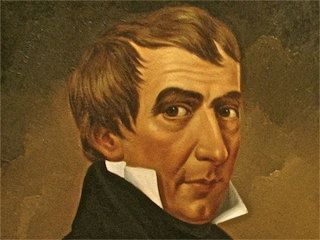 |
|
Furthermore, the Americans concept of land as property
was foreign to Indians thinking. |
William Henry Harrison |
| The importance of the island was identified as early as 1809 when it
was set aside as a federal military reservation by an Act of Congress. |
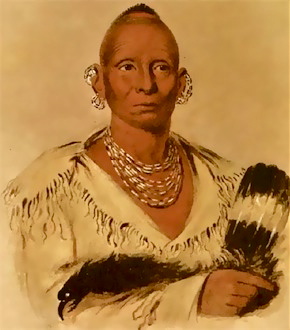 |
When war broke out between the United States and Britain in 1812, a
large band of Indians led by the Sauk warrior Black Hawk chose to fight
as auxiliaries for the British. A confidential message for Black Hawk,
from a British colonel, urged Black Hawk to raise a war party and join
the British force at Green Bay. Black Hawk raised the war party,
traveled to Green Bay, and for a time fought as an ally of the British
during the War of 1812. Black Hawk and his Sauk warriors were present
during the Fort Dearborn Massacre of August 15th, 1812. However, after
initial success, the fighting did not go well for the British, and Black
Hawk returned to his village on the Rock River. Though he returned to
the village, Black Hawk remained hostile towards the United States. On
three occasions during the War of 1812, Black Hawk led Sauk warriors
against U.S. military forces attempting to journey up river from St.
Louis. On December 24th, 1814, the War of 1812 concluded with the
signing of the Treaty of Ghent. Though peace with the British was
achieved, such was not the case with their Indian
mercenaries or allies.
Later, Black Hawk stated that Rock Island supplied his tribe with
fruits, nuts, and plenty of fish from the rapids. He said he spent happy
times on the island and that a good spirit lived in a cave in the rocky
bluffs beneath the fort. “But the noise of the fort has since driven him
away and no doubt a bad spirit has taken his place.” |
|
Sauk Indian Warrior - Black Hawk |
Fort Armstrong |
|
In 1816, Fort Armstrong was built as part of a
system of forts in the Upper Mississippi River Valley. The fort's most
important role in keeping the peace was when it served as military
headquarters during the Black Hawk War of 1832 |
|
Sauk warrior Black Hawk was the leader of the last
hostile Indian uprising in the State of Illinois, known as the Black
Hawk War of 1832
Fort Armstrong became the headquarters for military
operations during what would be known as the Black Hawk War. A company
of Illinois volunteers were stationed at Fort Armstrong as
reinforcements from April to June 1832. The company pulled garrison duty
and was composed of men from Rock Island and nearby counties. George
Davenport supposedly volunteered for duty during the Indian trouble and
received the commission of quartermaster at Fort Armstrong with the rank
of Colonel.
In the 15 weeks of the Black Hawk War, a majority of the
fighting actually took place in Northern Illinois and Southern
Wisconsin, even though the spark that ignited the conflict happened in
the vicinity of Rock Island. After Black Hawk had inflicted a
humiliating defeat on a detachment of 275 mounted volunteers commanded
by Major Isaiah Stillman at Sycamore Creek near Dixon Ferry, it was no
longer possible to settle the dispute peaceably. |
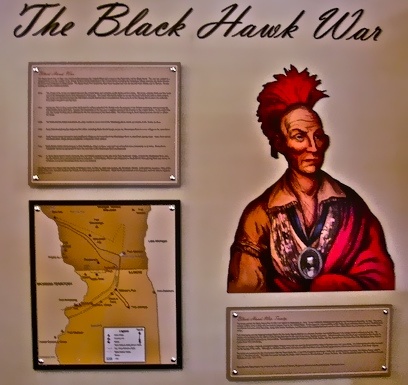 |
Major Stillman’s Rangers, anxious to fight Indians, had volunteered
to serve as a scouting party for the U.S. Regulars. Stillman’s troops
ignoring an opportunity to parley with Black Hawk, fired on Indian
messengers carrying a flag of truce. The Rangers pursued the few Indians
that escaped to Sycamore Creek, where Black Hawk attacked the Rangers.
Black Hawk and approximately 40 braves routed the volunteers. Stillman’s
mounted Rangers panicked and retreated. Only 11 volunteers actually were
killed in the skirmish, but their bodies were horribly destroyed. The
Indians had scalped them and mutilated them. The route of these
undisciplined volunteers became known in the Rock Island vicinity as the
Battle of Stillman’s Run. War could no longer be avoided.
Black Hawk’s band fled north, searching for a place to re-cross the
Mississippi River. During these weeks of flight, isolated attacks
occurred by small bands of warriors. The raiding Indians would sneak up
on a lone cabin, then murder, scalp, and steal provisions of the
inhabitants. The roving parties included Winnebago, Potawatomi, and
Kickapoo braves in addition to Sauk and Fox warriors. Besides attacking
lone cabins, the small bands of marauding warriors also ambushed
travelers.Many of the settlers serving as Rangers on the Illinois
frontier were just as savage. Several of these citizen volunteers took
Indian scalps as trophies during the campaign. |
Black Hawk and his followers continued north along the Mississippi
River searching for a place to cross. On 2 August 1832, General
Atkinson, with about 500 Regulars and some volunteers, caught up with
Black Hawk’s band in Southern Wisconsin at the confluence of the Bad Axe
River and the Mississippi. At the Battle of Bad Axe the Indians were
decisively defeated by federal forces with the aid of the steamboat
Warrior and its six-pound gun. Driven into the river by their pursuers,
the Indian warriors, their elders, women, and children were shot down or
drowned as they tried to escape. Many of those that reached the west
banks of the Mississippi were slain by a band of Sioux recruited by the
U.S. Army. Black Hawk, however, escaped with a small band. Two weeks
later, they were captured by Winnebago Indians who also had been
recruited by the United States Army.
Since the threat of Indian hostilities no longer existed, the War
Department removed the garrison at Fort Armstrong. Although the army
abandoned the fort in 1836, the government retained Rock Island as a
government reservation. |
|
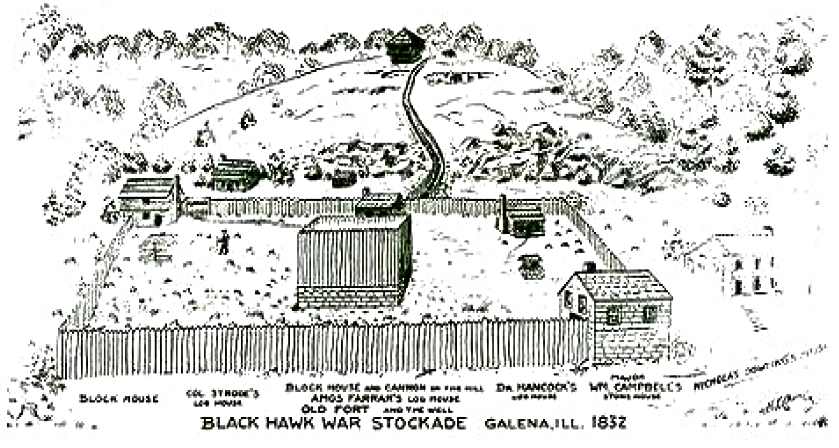 |
|
An Act of Congress established the
Rock Island Arsenal in 1862
During the American Civil War, 1861-1865, the United
States Army returned to Rock Island. This was the beginning of the
second, or arsenal construction period which continued until
approximately 1908 when the original Arsenal was completed and had its
first test in meeting the demands of the Spanish-American War and the
subsequent retrenchment.
This second period began on July 11th, 1862, when the United States
Congress passed an act which established an arsenal on Rock Island. The
next year, the Army Ordnance Department started construction of a
storehouse on the western tip of the island, near the ruins of Fort
Armstrong. This storehouse, completed in 1867, and known today as the
Clock Tower Building, was the first permanent arsenal building erected. |
|
Rock Island Civil War Prison
Barracks
General Meigs ordered to be built a prison barracks
large enough to accommodate 10,000 prisoners of war. In 1863, the U.S.
Army Quartermaster Department began to build a prisoner of war camp on
the north central section of Rock Island. By the time the Rock Island
Prison Barracks received its first Confederate prisoners-of-war in
December 1863, the Union Army had established 21 other prison sites.
During the course of the war, some of these prisons closed, while new
prisons opened.
During the twenty months, the active period of the
prison, 12,409 prisoners had been confined. Prison records cited
forty-one successful escapes. |
|
The Spanish-American War 1898
On February 15th, 1898, the U.S. battleship Maine blew up in
the harbor of Havana, Cuba. Many Americans believed that Spain, to whom
Cuba belonged, blew up the Maine. Congress, on April 19th, 1898
passed a resolution declaring that the people of Cuba should be free and
independent from Spanish rule. It also authorized military force to
carry out the resolution. Five days later Spain declared war on the
United States.
The Spanish-American War was the Rock Island Arsenal’s first major
test of its capabilities to meet emergency wartime production. The
United States Army was not prepared for war in 1898. It operated
primarily with Civil War era technology and supplies, and was
undermanned. by the time the war ended, the Arsenal’s manpower had
increased to six times its prewar figure.
The 19th
century came to a close with the Rock
Island Arsenal finally realizing the plan of Colonel Rodman, the first
Arsenal Commander to propose a combined arsenal and armory at Rock
Island. During the early 1900s, the United States Army’s transformation
from horse to auto drawn artillery occurred at the Rock Island Arsenal. |
|
 |
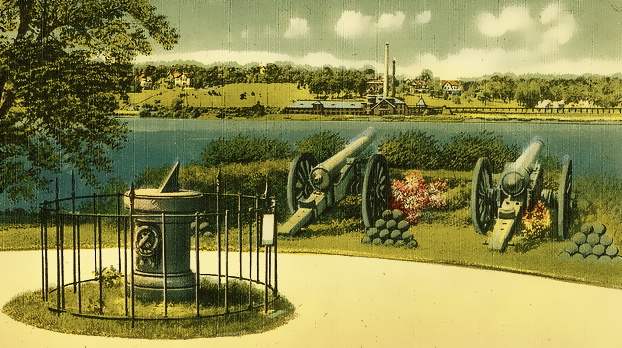 |
| Between 1863 and 1865, the federal government established a cemetery
of a little more than two acres for the burial of Confederate prisoners
of war. Approximately 1,950 soldiers died at the Rock Island Confederate
Prison, founded there in 1863. The first POWs, captured during the
battles of Lookout Mountain and Missionary Ridge in Tennessee, in
November 1863, arrived in December. Throughout the war, Confederates
were brought to Rock Island from battle areas throughout the South;
eventually, more than 12,000 POWs were confined there. Prisoners died
from a variety of causes, including exposure to the cold, harsh winters,
malnutrition and diseases such as smallpox. The Confederate Cemetery is
the only tangible remains of the Rock Island Prison Barracks. |
|
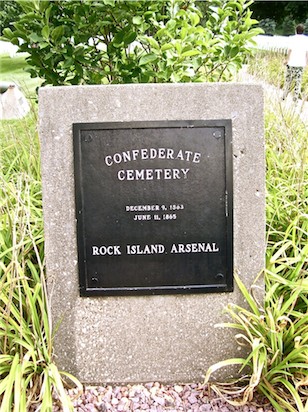 |
 |
| The Rock Island National Cemetery is one of 117 national cemeteries
operated by the Veterans Administration in the United States. Originally
established in 1863 as the post cemetery for Union prison guards at the
Rock Island Prison Barracks, this cemetery is among the 20 oldest
national cemeteries. The cemetery covers 70 acres and has approximately
24,000 grave markers. |
|
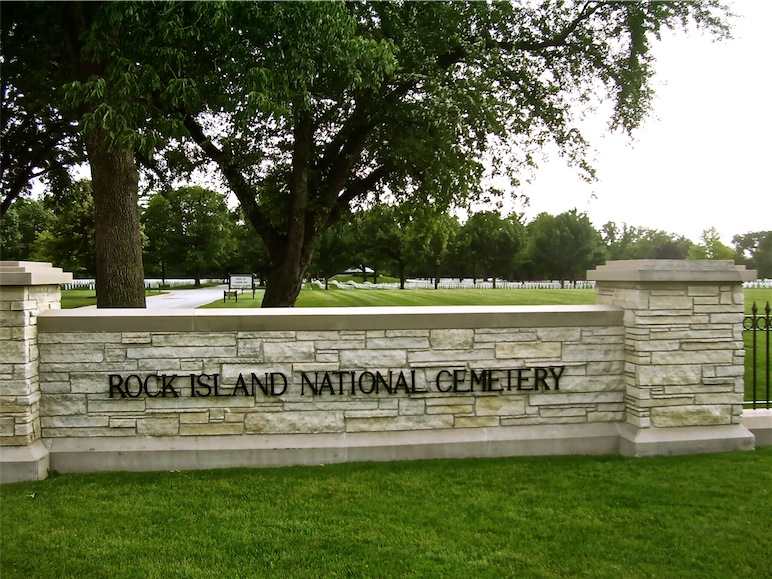 |
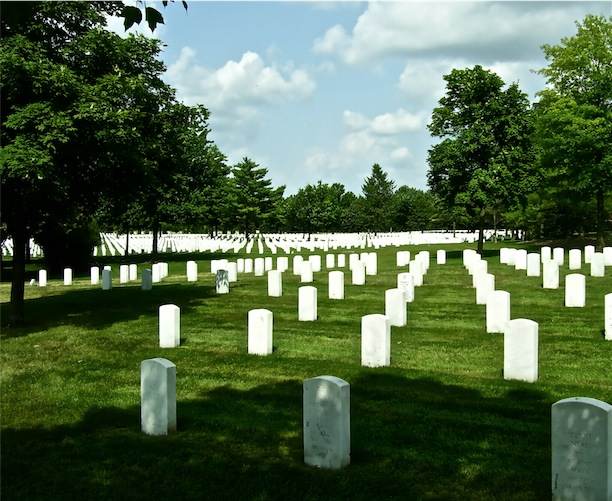 |
|
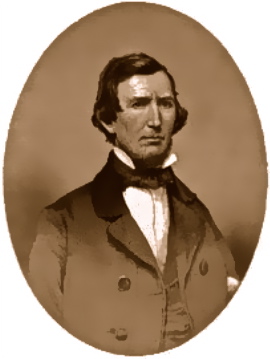 |
When George Davenport arrived with the U.S. Army in 1816, their
mission was to establish fortification in the wilderness for the U.S.
Government. The protection afforded by this fort attracted settlers to
this wild, rich land. As a settler, Davenport was in a position to
realize the possibilities of further trade with the Indians. He also
prospered as an Agent of the American Fur Company. He quickly branched
into other businesses, sending the first keelboat-load of lead down the
river to St. Louis.
During the Black Hawk Wars, Davenport was a fur trader and respected
citizen. This put him in a natural position to act as a mediator
between the Indians and the U.S. Government. The coming of the steamboat in 1823 into the upper Mississippi Valley
region brought more settlers and possibilities for further business
dealings. With his increased prosperity, Davenport wanted a home, which
he built between 1833-1834. The house became the center of local
commerce, a crossroads for trade in the region. Later, this home laid
the foundation for the Quad Cities of Iowa and Illinois.
Colonel Davenport's house is a structure that was considered a
mansion of its time. The house is located on the north side of Arsenal
Island in Rock Island, Illinois |
|
The Murder of Colonel Davenport
On July 4th, 1845, robbers murdered Colonel Davenport at
his island estate. Rumors of $20,000 in gold, supposedly hidden on the
Davenport property, attracted the robbers to the island. Colonel
Davenport’s wife and two sons had gone to an Independence Day
celebration in the city of Rock Island. Finding the Colonel alone, the
four bandits shot, stabbed and tortured him. However, they departed the
island with only a few hundred dollars they had found in the house.
Colonel Davenport died from the wounds inflicted upon him by the
robbers.
A few months later, on October 29th, 1845, John Long, Aaron Long, and
Granville Young were hanged in the town of Rock Island for the murder of
Colonel Davenport. The three outlaws were members of the notorious
“Banditti of the Prairie” gang. Unfortunately, for Aaron Long, his rope
broke. The sheriff supposedly supplied him with a stiff drink, then
hanged him a second time. As for Aaron’s brother, John Long, his body
was supposedly shipped to a physician in a barrel of rum. The physician
displayed Long’s skeleton in his office. |
 |
|
When the city of Davenport, Iowa was mapped out, the
city was named after Colonel Davenport. |
Colonel Davenport House |
Once you've been to the Rock Island Arsenal, it's hard to forget
Memorial Park. There's everything from tanks, cannons, and even rocket
launchers on display. The park was built after World War II as a way to
honor the civilian employees of the Arsenal who died during the course
of the war.
And everything you'll find at the park has a story all its own, from the
Sherman Tank with battle wounds, to the Soviet-made vehicles used by the
Iraqi army in the Gulf War.
Memorial Park is populated with a large number of guns, many of which
have association with the Arsenal; either developed there or as part of
the design process. But some are also trophies from other wars that made
their way to the Arsenal. The one that stands out from all the rest is
the M-65 ATOMIC CANNON. The 47-ton cannon was designed right at the
Rock Island Arsenal. |
|
Memorial Park Pavilion - Heavy
Weaponry |
|
Rock Island Arsenal Museum |
The Rock Island Arsenal Museum is the Army’s second oldest museum.
It first opened to the public on July 4th, 1905. The primary mission is
to collect, preserve, and interpret the history of Rock Island Arsenal
and Arsenal Island.
The Rock Island Arsenal Museum is nationally recognized for its large
and impressive small arms collection. Over twelve hundred U.S.,
foreign, civilian, and military small arms are on permanent display. |
|
First World War - Rifles |
Colt 45 - Smith & Wesson 38 |
|
Trench Warfare |
19th Century Naval Revolver |
|
Matchlock Firearm |
United States Weapons - Korean War |
|
M15 Pistol |
Replica - George Washington's Revolutionary War Sword |
|
Semi-automatics |
Union Swords - Civil War |
|
Iraqi Assault Rifle |
Cavalry Sabers |
|
M16 Assault Rifle |
Samurai Swords |
|
1892 Bayonet - Krag Rifle |
Nazi SS Dagger |
|
Sniper Scoped |
M9 Bayonet System |
|
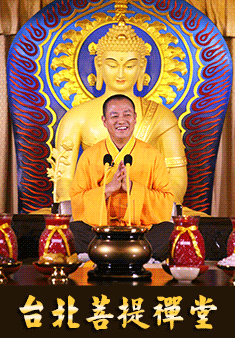 |
 |
|
Derived from Ancient Buddhist Theory
Methodology that Stimulates Physical
Renewal and Promotes General Health |
 |
Los Angeles Bodhi Meditation Center
20657 Golden Spring Drive #111
Diamond Bar, California
91789, U.S.A.
(626) 457-5316
Sunday - August 3rd, 2014
Green Dragon Society
Attended Meditational Seminar
Bodhi Meditation applies traditional practices to the
challenges of modern living.
The result is a uniquely effective meditation system that
holistically enhances immunity, stamina and state of mind.
The techniques are accessible and practical.
|
|
The Art Institute of Chicago
collects, preserves, and interprets works of art of the highest quality,
representing the world’s diverse artistic traditions, for the
inspiration and education of the public |
| The Art Institute of Chicago was founded as both a museum and school
for the fine arts in 1879, a critical era in the history of Chicago as
civic energies were devoted to rebuilding the metropolis that had been
destroyed by the Great Fire of 1871. Its first collections consisting
primarily of plaster casts, the Art Institute found its permanent home
in 1893, when it moved into a building, constructed jointly with the
city of Chicago for the World's Columbian Exposition, at the
intersection of Michigan Avenue and Adams Street. That building, its
entry flanked by the two famous bronze lions, remains the "front door"
of the museum even today. |
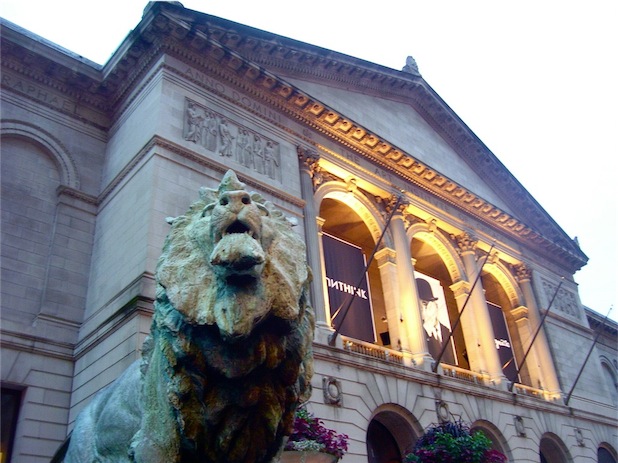 |
The Art Institute of Chicago
111 South Michigan Avenue
Chicago, Illinois 60603
Museum Hours
Open daily 10:30–5:00
Thursday until 8:00
Thursday - August 21st, 2014
Green Dragon Society
Field Trip
The permanent collection to nearly 300,000 works of art
in fields ranging from Chinese bronzes to contemporary design and from
textiles to installation art. Together, the School of the Art Institute
of Chicago and the museum of the Art Institute of Chicago are now
internationally recognized as two of the leading fine-arts institutions
in the United States. |
|
Between 1890 and 1917, the institute was transformed
from a separate sphere intended to realize the ideals of its patrons to
an institution dedicated to bringing art to a wider public and serving
as the hub of the city's artistic life. The institute has continued to
pursue this mandate through a program of temporary exhibitions,
lectures, concerts, and classes. The museum has also broadened the range
of its collections to encompass Asian, African, Amerindian, and American
arts and has expanded into new media including photography and
architecture. |
|
 |
|
The Art Institute's distinguished Asian collection
comprises works spanning nearly five millennia from China, Korea, Japan,
India, southwest Asia, and the Near and Middle East. It includes 35,000
objects of great archaeological and artistic significance, including
Chinese bronzes, ceramics, and archaic jades; Chinese and Japanese
textiles; Japanese screens and paintings; Indian and Persian miniature
paintings; and Indian and Southeast Asian sculpture. The collection of
Japanese woodblock prints is one of the finest in the world. |
|
Buddhist Dakini |
Sovereign of the Clouds of Dawn |
|
Dagger Axe_Shang Dynasty |
Chinese Decorative Box |
|
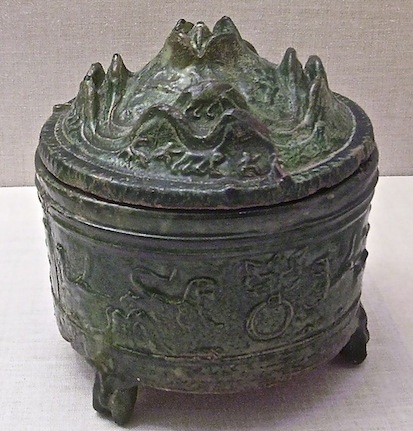 |
 |
Cauldrons and storage vessels are important in
Chinese Taoist Alchemy. They are used to brew the formulas. They are
essential for preparation and ageing of Elixirs, Medicines, Taoist Medicinal Wines
and external Liniments. |
|
Tripod Cauldron |
Tripod Cauldron_7th to 4th Century BC |
|
Wine Vessal_1700 to 1000 BC |
Liquid Flask_4th Century BC |
|
Liquid Basin_Bronze 9th/7th Century
BC |
|
Krishna Yamari (Six-Faced Conqueror of Death) on
Buffalo |
Lion Headed God Vishnu (Hindu) |
|
Shiva and Uma Seated (Hindu) |
Shiva's Dance (Hindu) |
|
Seated Bodhisattva - Japan_775 AD |
Fudo Myoo - Japan_12th/14th Century AD
The Immovable or Unshakeable One_Lord of Light |
|
Bishamonten - Japan_11th Century AD |
Thunderbolt Deity - Japan_12th to 14th Century AD |
|
Kumara - (Youthful God of War) on Peacock Mount |
Tantric Dieties |
|
Guardian Figure - Java |
Serpent King - Vietnam |
|
Crowned Buddha - Burma |
Ceremonial Knives - Mexico_200 AD |
|

Sound the trumpets! Highlights of the Art Institute’s
spectacular collection of arms and armor are on special display.
Featuring full suits, half suits, pole arms, cannons, and, for the first
time at the Art Institute, a knight on horseback, this installation
includes tapestries, paintings, and sculpture, bringing the viewer
closer to the world where these objects might have been seen gleaming on
the parade ground or heard clanging on the battlefield. Both young and
old alike can marvel at the artistry and craftsmanship in these
remarkable pieces of not-so-ancient history. |
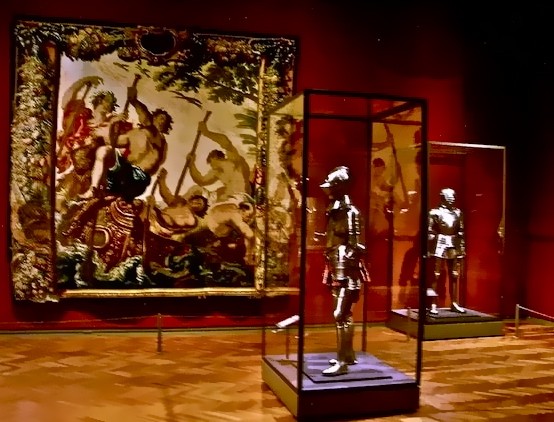 |
|
German Field Armor_1520 AD |
Armor for Field & Tournament |
|
Italian (Milan) Armor_16th Century AD |
|
"Katchef Dahouth, Christian Mameluke"_1804 |
"Horseman Attacked by Lion" |
|
"Hercules and the Hydra" by Gustave Moreau_1876 |
"The Guard House" |
|
The Oriental Institute of the University of Chicago
is an interdisciplinary research center whose goal is to integrate
archaeological, textual, and art historical data to understand the
development and functioning of the ancient civilizations of the Near
East from the earliest Holocene through the Medieval period. We achieve
this by conducting archaeological excavations, artifact analyses, the
development of new research methodologies, the stewardship of systematic
museum collections, philological studies, historical research, and the
development of dictionaries of ancient languages |
|
The Oriental Institute
Located on the campus of the University of Chicago
In Hyde Park, at 58th Street & University Avenue
1155 East 58th Street, Chicago, IL 60637
(773) 702-9520 - Museum Office
Open - 10 AM to 5 PM
Closed Mondays
Admission is Free
Tuesday - September 23rd, 2014
Green Dragon Society
Field Trip
One of the great strengths of the
Oriental Institute’s archaeological program is its vast regional
coverage across geopolitical boundaries and its time depth. Experts in
Mesopotamian, Syro-Palestinian, Anatolian, Iranian, Egyptian, and Nubian
archaeology. All work in the same building to offer research, teaching,
and field projects for the entire Near East, with a temporal depth of
coverage from the Neolithic through the Islamic period. Concentration on
the well attested cultures of the third through the first millennia B.C.
This critical mass of scholarship in complementary disciplines is
unmatched anywhere in the world. |
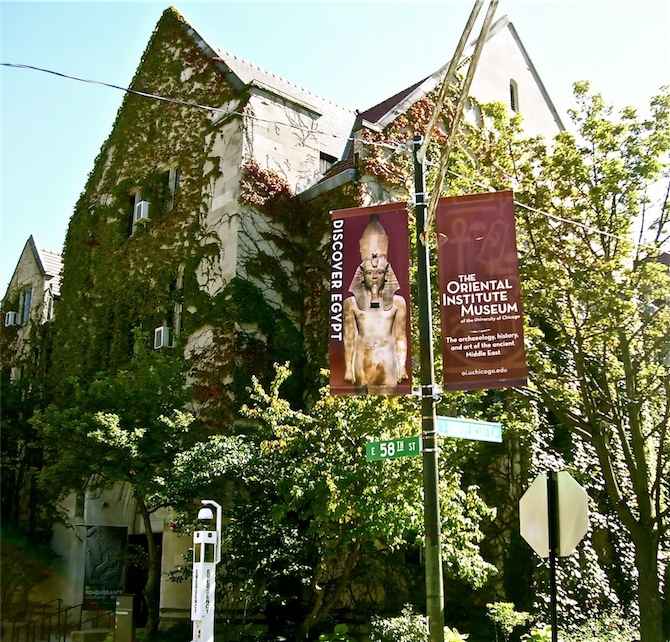 |
| The Oriental Institute has sponsored archaeological and survey
expeditions in nearly every country of the Near East. Eight field
projects are currently active in Egypt, Iran, Sudan, Syria, and Turkey.
These completed and ongoing excavations have defined the basic
chronologies for many ancient Near Eastern civilizations and made
fundamental contributions to our understanding of basic questions in
ancient human societies, ranging from the study of ancient urbanism to
the origins of food production and sedentary village life in the
Neolithic period. The Institute also focuses on the development of new
methodologies for field research such as the advanced remote sensing
procedures and protocols developed by the Institute’s CAMEL (Center for
Ancient Middle Eastern Landscapes) laboratory. |
|
University of Chicago Campus |
|
Catholic Church |
Oriental Institute Auditorium |
Modern Sculpture |
|
Carl von Linné - Statue |
Statue at the "Fountain of Time" |
|
Oriental Institute Museum
|
|
Egyptian Cat (Bast) |
Egyptian Falcon (Horus) |
|
Nubian Tribute to Tutankhamun . . . circa 1336 BC |
Family Portrait |
|
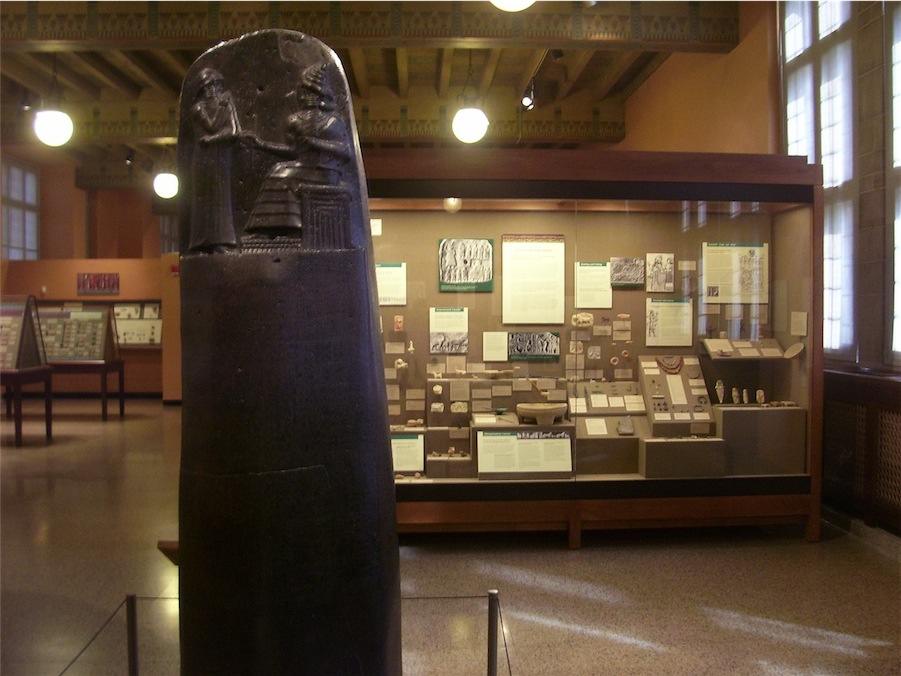 |
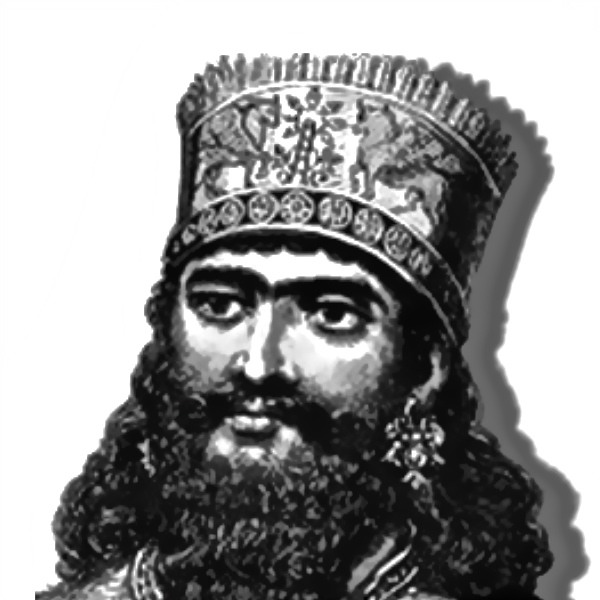
Oriental Institute
Babylonian Exhibit
Laws of Hammurabi
Ancient Monolithic Stone
(Photo Left)
|
| This tall pillar is called a stela and is inscribed with the
famous collection of laws created by the great Mesopotamian King
Hammurabi (1792-1750 BC). The scene at the top shows the King standing
before the Sun God Shamash, who was also the Mesopotamian 'God of
Justice'. Sitting on a throne, with rays of sunlight coming from his
shoulders, Shamash gives Hammurabi a rod and ring, symbols of kingship.
Below the carved scene, the rest of the pillar is covered with ancient
Mesopotamian cuneiform script recording approximately 300 laws. |
|
Painting - "Ishtar Gate" by Maurice
Bardin_1936 (Babylon) |
Painting - "View of the City of
Babylon" by Maurice Bardin_1936 |
| The spectacular "Ishtar Gate", one of the great
monuments of antiquity, is pictured; showing a reconstruction view of
the city of Babylon. The gate was decorated with large, colorful dragons
and bulls made of molded bricks. Guarding the Processional Way, which
was the approach to the Ishtar Gate, were about 60 glazed lions striding
along either side of the base of the high walls. This imposing entryway
to the city was built by King Nebuchadnezzar II of Babylon around 580
BC, to honor the powerful Mesopotamian "Goddess of Love and War",
Ishtar. |
|
|
Mesopotamia is where the world's first cities appeared about
4000-3500 BC. This Painting shows how the ancient city of Babylon may
have looked around 604 to 562 BC. With a population of at least 200,000
people Babylon was a marvel of the ancient world. In the foreground is
the Euphrates River, which ran through the center of the city. Next to
the Euphrates is the sacred temple complex of the God Marduk, which
includes the ziggurat that many people believe to be the famous "Tower
of Babel" from the Bible. |
|
 |
|
 |
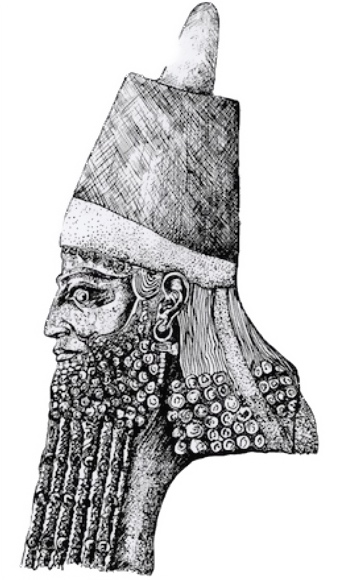
Sargon II - King of Assyria_722 BC |
|
Assyrian - Double Horse Column Pinnacle |
Black Obelisk of Shalmaneser III |
|
 |
|
 |
The Assyrians took their warfare seriously; in fact they studied war
techniques like a science. The Assyrians even had special schools set up
to teach sapping (military demolition of walls, etc) and mining city
walls. The Assyrians were the innovators of war in their time. The
Assyrian army was feared for many reasons one including the use of iron
in their weapons. The Assyrians were the first to use iron in spears,
swords, shields and armor. They even tipped their battering rams for
extra effectiveness. Against iron spears and swords, bronze shields were
useless. The Assyrians had the most advanced weapons of their time.
In addition they possessed advanced engineering skills, effective
tactics, and most importantly, a complete ruthlessness which came to
characterize the Assyrians to their neighbors and subjects and still
attaches itself to the reputation of Assyria in the modern day. A phrase
oft-repeated by Assyrian kings in their inscriptions regarding military
conquests is "I destroyed, devastated, and burned with fire" those
cities, towns, and regions which resisted Assyrian rule.
Assyria is the first society to make militarism the central policy of
state. A regular event each spring is the departure of the army for
conquest. At the head of the march are standard bearers and priests;
behind them come the king and his bodyguard, followed by the chariots,
the cavalry, the infantry and, bringing up the rear, the baggage train.
This great cavalcade moves outwards through territories already under
Assyrian control, growing as it moves, for each region is required to
contribute troops. Eventually the great army reaches previously
unconquered areas.
Though the Assyrians and their army were respected and feared, they were
most of all hated and the subjects of their empire were in an almost
constant state of rebellion. The Assyrian war machine was the most
efficient military force in the ancient world up until the fall of the
empire in 612 BC. |
|
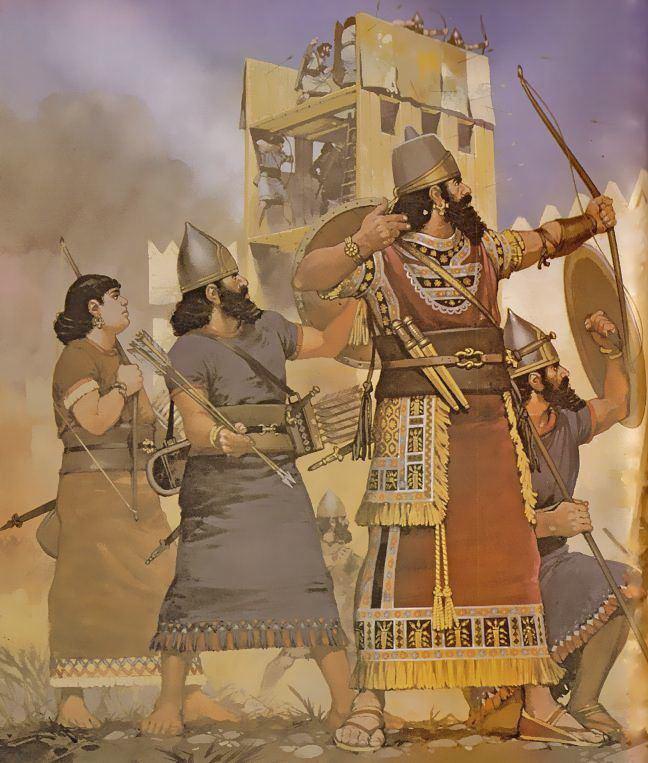 |
 |
|
Assyrian Siege Warfare - Ashurnasirpal II . . .
circa 9th Century BC |
|
Assyrian Chariot and Infantry . . . circa 9th
Century BC |
Assyrian Cavalry . . . circa 9th Century BC |
| |
Assyrian Campaign of Tiglath-Pileser III -
Late 8th Century BC |
Assyrian & Auxiliary Infantry - Late
8th Century BC |
|
Sennacherib at Lachish . . . circa 701 BC |
Sargonid Cavalry - Urartu . . . circa 714 BC |
|
Assyrian Royal Guardsmen . . . circa 7th Century BC |
Assyrian Troops in Babylonia . . . circa Early 7th
Century BC |
| |
Assyrian Heavy Chariot - Ashurbanipal in Late 7th
Century BC |
Assyrian Cavalry & Infantry . . circa 655 BC |
|
Assyrian Sword Types & Maces |
|
The bas-reliefs covering the Neo-Assyrian period
include a multiplicity of sword types and maces. Those of the 9th
century were more ornate than those of the 7th century, by which time
mass production in the 'ekal masharti' arsenals led to simpler and more
functional designs. |
|
Assurnasirpal II
Personal Sword
9th Century |
|
Cavalry Trooper
Sword
9th Century |
|
Officers Mace
9th Century |
|
Infantry Sword
Reign of
Tiglath-Pileser III
8th Century |
|
Officers Mace
King's Bodyguard
Sennacherib Reign
Early 7th Century |
|
Infantry Sword
7th Century |
|
|
Canaanite God El - at Megiddo
Circa 1400 to 1200 BC |
Neo-Hittite Sphinx - Ancient Turkey
1800 to 1100 BC |
Red Lustrous Spindle Bottle - Cyprus
1500 to 1400 BC |
|
Kali: The Power of Destruction over
Negative Ego |
|
Kali is considered a Manifestation of
Supreme Power
Deity of Time and Eternity |
|
Kali is the Foremost of the Ten
Incarnations of the Hindu Goddess Durga
Regarded as her Aggressive Form |
 |
Vivekananda Vedanta Society of
Chicago
14630 Lemont Road
Homer Glen, Illinois, 60491
(708) 301-9062
Thursday - October 23rd, 2014
Green Dragon Society
Attended Puja
Hindu Goddess Kali
It is believed that Kali Puja helps one
maintain sanity in the inner world
As much as it helps in elimination of evil from the outer world
|
|
For Kali, more than on any other day, is the Kali
Puja, a ritual celebrated on the new moon day of the Hindu month of
Ashwin in Bengal, on the night of Kartik Amavasya, in October or
November, which is considered the greatest form of Kali Ritual. Unlike
with other festivals, believers will perform Kali Puja at night. Typically,
people gather around elaborate shrines to the Goddess in late evening. Pujari (priests) will then lead a ceremony, which may involve prayers,
meditation, chanting of mantras; with offerings of red hibiscus flowers,
sweets, sweetmeats, and other flowers. Puja may continue very late into
the night. People also decorate their homes with lights and candles.
Firecrackers and magic shows are common on the Kali Puja. Kali Puja coincides with Dewali, a well-known celebration observed by Hindus,
Sikhs, and Jains in India and other countries. |
| Vedanta Society history is inextricably tied with the history of Chicago and the
World's Columbian Exposition of 1893. It was during the 1893 Columbian
Exposition's Parliament of Religions that a young monk named Vivekananda
burst upon the Western world and it was given to Chicago to first
receive his “message to the West as Buddha had a message to the East.”
Numerous places in and around Chicago are filled with his memories and
footprints. |
|
"The Parliament of Religions"
1893 World's Columbian Exposition
Chicago
The Parliament was a unique phenomenon in the history of
religions. Never before had representatives of the world's great
religions been brought together in one place, where they might without
fear tell of their respective beliefs to thousands of people.
The Parliament of Religions opened on the morning of
September 11, 1893 at the newly constructed Art Institute of Chicago
(before it had started housing the art exhibits for which it is now
famous).
At ten o'clock, ten solemn strokes of the New Liberty
Bell, on which was inscribed "A new commandment I give unto you, that ye
love one another", proclaimed the opening of the Parliament -- each
stroke of the bell representing one of the ten chief religions — Theism,
Judaism, Mohammedanism, Hinduism, Buddhism, Taoism, Confucianism, Shintoism, Zoroastrianism, Catholicism, the Greek Church, and
Protestantism.
Swami Vivekananda was conspicuous. He was described by
an individual present for his "gorgeous red apparel, his bronze face
surmounted with a turban of yellow. "Another described him as, the "Brahmin Monk,
Swami Vivekananda, with his flowing orange robe, safforn turban,
smooth-shaven, shapely handsome face, large, dark subtle penetrating
eyes, and with the air of one being inly-pleased with the consciousness
of being easily master of his situation. His knowledge of English is as
though it were his mother tongue.”
The electric effect on the audience of the first words
Swami Vivekananda spoke is well known. Neely's History comments that
“when Mr Vivekananda addressed the audience as 'Sisters and Brothers of
America,' there arose a peal of applause that lasted for several
minutes.” |
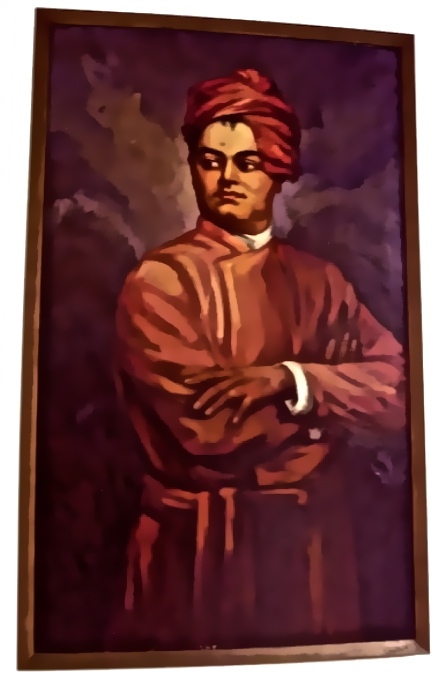 |
| Mrs. S. K. Blodgett, who much later became the Swami's hostess in
Los |
Swami Vivekananda |
| Angeles, recalled “I was at the Parliament ...when that young man
got up and said, 'Sisters and Brothers of America,' seven thousand
people rose to their feet as a tribute to something they knew not what." |
|
Maha Kali |
Vivekananda Vedanta Society - Bookstore |
|
Buddhas at Vivekananda Vedanta Society |
|
Vedanta does not ask us to believe in any particular
form or idea of God, or subscribe to any particular religion — it only
asks that we be bold and sincere in our search for the Truth. It says
that religion is not dogma or doctrine, but must be verified and
experienced and that this experience of the Truth, of one's real Self,
is the ultimate goal of life. |
|
Vivekananda Vedanta Society Altar |
Kali Puja Altar |
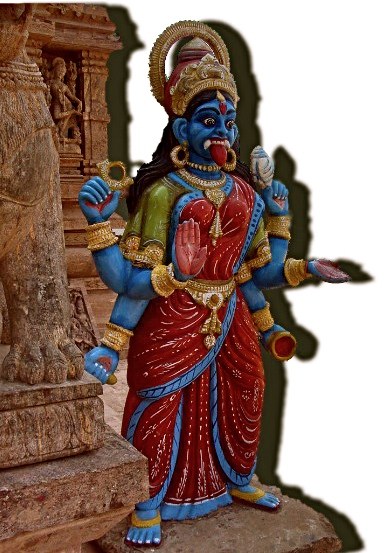 |
Kali Puja Legend
The legend goes that long ago the demons, Shambhu and
Nishambhu, disturbed the peace of Indra, the King of Gods, and his
Empire of Heaven. After extensive and endless battles, the gods lost all
hope and the demons became stronger.
The gods took refuge in the Himalayas, the holy mountains, the home of
Lord Shiva. The shaken gods sought protection from Mahamaya Durga, the
Goddess of Shakti. Kali was born from Durga's forehead, created to save
heaven and earth from the growing cruelty of the demons. Along with
Dakini and Jogini, her two escorts, she set on her way to end the war
and kill the devils.
There was chaos all around. After slaughtering the demons, Kali made a
garland of their heads and wore it around her neck. In the bloodbath,
she lost control and started killing anyone who came her way. The gods
started running for their lives. The only source of protection seemed
Lord Shiva.
Seeing the endless slaughter, Shiva devised a plan to save the world. He
lay down in the path of the rampaging Kali. When the goddess unknowingly
stepped on him, shocked at this sight, Kali stuck out her tongue in
astonishment, and put an end to her homicidal rampage. Hence the common
image of Kali shows her in her mêlée mood, standing with one foot on
Shiva's chest, with her enormous tongue stuck out.
That momentous day is celebrated ever since. Kali Puja is performed
essentially to seek protection against drought and war, for general
happiness, health, wealth, and peace. It is a Tantric Puja |
|
Despite Kali's fearful appearance, the relationship
that devotees share with her is that of a loving and caring mother |
|
"My child, you need not know much in order to
please Me.
Only Love Me dearly.
Speak to me, as you would talk to your mother,
if she had taken you in her arms." |
|
The Goddess's fearsomeness is also the source of Kali's
strength, which is why during Kali Puja believers make appeals for her
protection from harm and ask Kali to destroy various evils. It's
believed that Kali Ritual cuts down all impurities, consumes all
inequity and also the darkness within the devotees themselves. It is
also believed that Kali Ritual destroys all evil, that lies both
inside and outside of her devotees. |
|
Artistic Interpretations of Kali
|
|
The Museum, which opened in early
June, contains an impressive collection of Paintings, Carvings, Rare
Stones, Furniture and more, some of it dating Thousands of Years |
|
The Mission of the Heritage Museum
of Asian Art - Preserve and Promote the Tradition of Asian Art for the
Enrichment of Present and Future Generations |
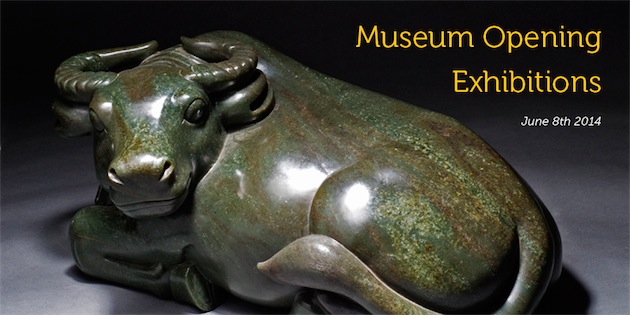 |
Established in 2014, in the heart of Chicago’s Chinatown, the
Heritage Museum of Asian Art showcases a variety of artistic forms,
spanning many cultures and time periods of Asia.
The Heritage Museum of Asian Art was founded by long time Asian
art dealer and respected connoisseur, Jeffrey Moy. His sole purpose for
the museum was to share his love of Asian art with the surrounding
community. The museum provides a link to the past and present arts of
Asia for Chicagoans and visitors from all around the world. Moy said he
opened the museum as a way to give back to Chinatown. "What I'm trying
to do is bring back more culture to the community," he said. |
|
The Heritage Museum of Asian Art’s collection
includes a variety of art forms spanning many cultures and time periods
of Asia
Highlights of the collection include Jade dating from the Neolithic to
the Ching
Neolithic pottery, Imperial porcelains, Chinese snuff bottles, Scholar’s
objects, textiles, bronzes and more
Classical Chinese furniture also adorns the Heritage Museum’s galleries,
including cabinets, chairs, and a unique alcove bed |
Guests at the serene space will see jade ornaments, hand-painted
porcelain, ornately carved stonework and furniture, including an alcove
bed dating to the 18th century. "A half-dozen of these exist in the
world," Moy said of the bed. "This one is in pristine condition."
Many of the artifacts, like a roughly 10-by-40 wooden screen adorned
with hand-carved stone statues, originally were in the palaces of
wealthy Chinese. Some of the other pieces, like the ornamental Jade
"funeral mask," were salvaged during excavations as the Chinese
landscape underwent massive industrial changes. |
|
Palace Guardian |
Fu Dog Temple Guardian |
|
Ceremonial Stone Dagger - Warring States Period |
Bronze Halbard - Shang Dynasty
(1600-1046 BC) |
|
Lohan in Grotto - 18th Century China |
Carved Mountain Grotto with Buddha
(Lapis Lazuli) . . . circa Ching Dynasty |
|
Bronze Mirror w/Dragon & Phoenix
Tang Dynasty |
Bronze Mirror
Western Han Dynasty |
Bronze Mirror w/Dragons
Western Han Dynasty |
|
Jade Pendants - Hongshan Culture . .
. circa 3500 BC |
Jade Dragons - Warring States Period |
|
Japanese Monkey . . . circa 1890 |
Chinese Fan - 19th Century |
|
Naturally eroded rocks, combined with streams and
pools, are essential elements of a classical Chinese garden. Rocks
represent mountains, which because of their height are seen as a bridge
between earth and heaven. Mountain caves are said to be the home of
immortal beings.
Rocks in gardens, and miniature ones collected to place on a scholar’s
desk, are there to be contemplated. By studying their craggy shapes, a
viewer can imagine climbing hills, entering the immortals’ caves, and
feel the ease of having his or her spirit roam freely in the world. |
|
Forbidden City Painting |
Chinese Scholars Rock |
The Chinese interest in collecting rocks for religious or aesthetic
purposes has been traced back to the Han Dynasty (206 BC-AD 220)
when Chinese connoisseurs began using large stones to decorate their
gardens and courtyards. There are also references to the special
qualities of garden rocks and individual stones in poems dating as far
back as the Tang Dynasty (618-907 AD).
Scholar's Rocks is the most common English name given to the
small, individual stones that have been appreciated by educated and
artistic Chinese at least since the Sung Dynasty (960-1270 AD).
They evolved from appreciation of the larger garden rocks, but their
smaller size enabled the Chinese literati to carry them indoors where
they could be admired and meditated over in their sparse studios.
Scholar's Rocks began as stones that resembled or represented
mythological and famous mountains, or even whole mountain ranges in
China. Some are also appreciated simply for their dramatic form, their
wondrous colors, or feelings they evoke from the viewer. |
 |
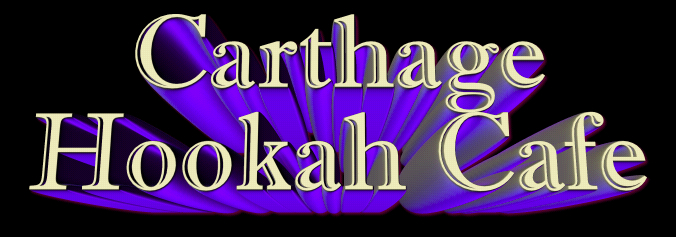 |
|
 |
|
Carthage Cafe - Expensive
Egyptian Hookahs |
|
The Hookah was invented over 500
years ago in the Middle East |
|
An Oriental Tobacco Pipe - which is a Water Pipe
With a long, flexible tube, that draws the smoke through water,
contained in a bowl
The hose running through its water-filled base is the key to enjoying
the sweet pleasures of Shisha
(Tobacco mixes of Molasses, Honey, and a variety of Fruit Flavors) |
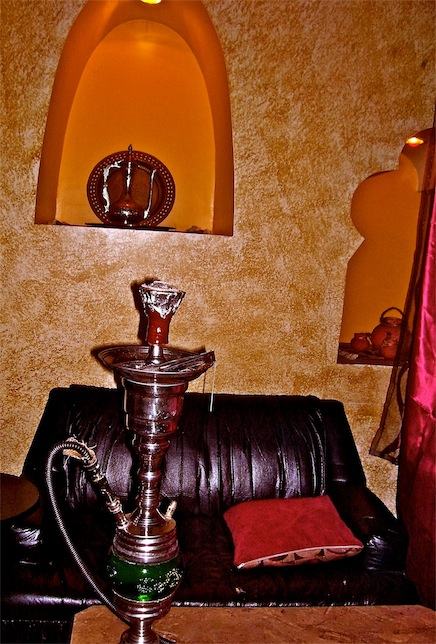 |
Carthage Hookah Cafe
3446 West Foster Avenue
Chicago, IL 60625
(773) 539-9004
Hours
Monday thru Thursday - 5:00 pm to 2:00 am
Friday & Saturday - 5:00 pm to 3:00 am
Sunday Closed
Saturday - December 20th, 2014
Green Dragon Society
Gathered at Hookah Lounge
A relaxed spot for Hookahs in many exotic flavors, and deep discussions
on many exotic subjects; amid a dark, Middle East inspired decor. When
you smoke a Hookah, you have time to think. It gives you an appreciation
of good company. Plenty of private spaces are available for use, and
there are extremely comfortable couches and chairs to sit in as well.
BYO food & drink. A really cool and very friendly lounge.
The Hookah in its primitive form originated in India. It soon travelled
west to Iran, Turkey, and Egypt where it gained mass popularity and are
now the sites of some of the best quality Hookahs in the world.
The Hookah Lounge has clear antecedents in the tradition of coffee
houses in the Middle East and Turkey, where people smoke tobacco from
Hookahs or other styles of Water Pipe provided by the establishment. In
this traditional setting the Hookah is typically of the single-hose
variety. This is in contrast with the multi-hose variety favored in the
Hookah Lounge and intended to emphasize the communal nature of the
activity. |
|
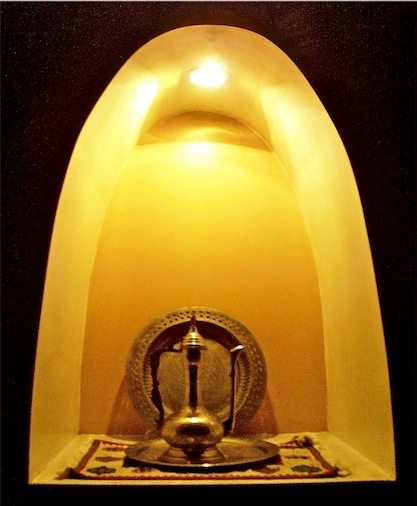 |
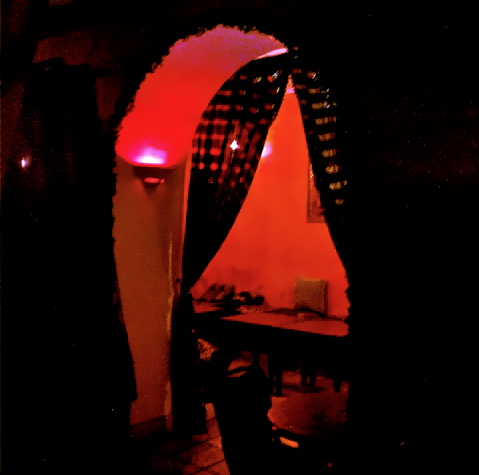 |
|
 |
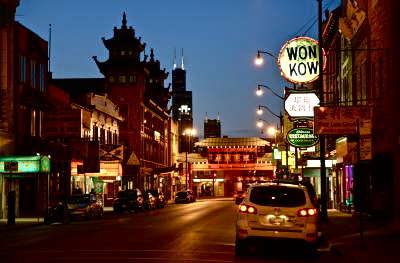 |
|
Shortest day of the year, Longest
night of the year |
|
Since ancient times in China, the
Winter Solstice has been considered just as significant as the Spring
Festival |
|
In old China, this was the day that
the Emperor would worship at the Temple of Heaven in Beijing
(One of the Chinese nation's most important Ceremonies) |
 |
Won Kow Restaurant
2237 S. Wentworth Ave
Chicago - Chinatown
312-842-7500
9 a.m. to 11 p.m. Sunday-Thursday
9 a.m. to midnight Friday and Saturday
Sunday - December 21st, 2014
Green Dragon Society
Winter Solstice Dinner
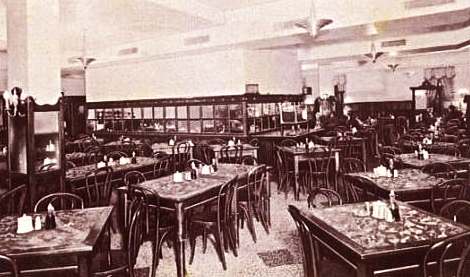 |
|
Won Kow - Oldest restaurant in Chicago's Chinatown
|
Won Kow . . . established in 1928 |
|
Chinese Traditions of the Winter
Solstice |
The Winter Solstice (Dec. 21st, 2014), occupies an important
place in the pantheon of traditional Chinese festivals. Known in
Mandarin as Dongzhi, the shortest day of the year is seen as the
year's turning point: from here on out, the days become ever brighter.
The darkness of Yin slowly gives way to the light, or Yang, completing
one leg in the endless cycle of time.
Dongzhi has had an important place in Chinese tradition for
thousands of years. From the Shang and Zhou Dynasties to the Qin Dynasty
(221 BC-AD 206), the Winter Solstice was considered the start of the
new year.
In the Han Dynasty (206 BC–AD 220), Dongzhi was an imperial holiday
marked by the recess of most official and military services, closure of
the borders, and the halt of commerce. For hardworking and tireless
people of all classes, it was a rare day of well-deserved rest.
Beginning in the Tang and Sung Dynasties, Dongzhi became a day of
Ancestral Worship, and the Emperor would hold a grand ceremonial ritual
to pay his respects to Heaven. The Temple of Heaven in Beijing was
constructed some 600 years ago for this function.
The 'Worship of Heaven' is a core tenet of traditional Chinese
belief, which emphasizes the importance of following the Heavenly way
and abiding by natural laws. As the extreme of Winter ushered in a new
period, it was a time of reflection and pause for the whole Empire.
The 'Act of Ritual', famously espoused by Confucius, played a
central role in the Spirit of ancient Chinese leaders and their
subjects. Humbling himself and his people before the 'Infinite Grace and
Might of the Celestial Realm', the ancient monarch gave thanks to
Heaven and acknowledged humanity’s place in the natural World.
Dongzhi is typically celebrated by eating food such as dumplings and
wontons that help the body stay warm. The vastness of China’s geography
means that specific traditions vary from region to region. In the chilly
north, there is an emphasis on the consumption of meats and drinks
considered “hot” in traditional Chinese Medicine, while southern habits
focus on the Tangyuan Dumpling, which is a sweet and sticky dish. |
|
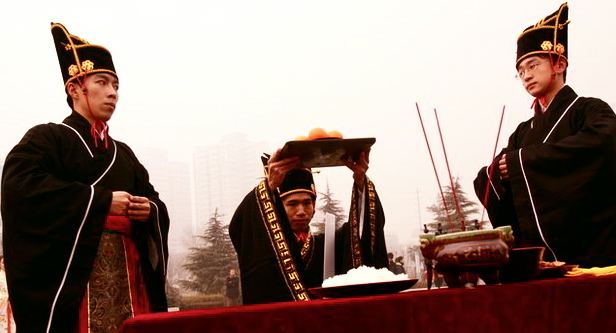 |
|
Chinese dressed in Traditional Han
Costumes - Offer fruits as 'Sacrifices to Heaven' during a Ceremony to
mark the Winter Solstice Festival |
|
‘Patron Buddha’ of Thailand - The
Four Faced Buddha |
|
Famously called as the Four Faced
Buddha
Thailand’s unofficial Patron Buddha is actually not a Buddha
It is a "Brahma" and technically it has nothing to do with Buddhism |
|
"4 Faced Buddha Birthday Ceremony"
Wong Tai Sen Taoism Temple
529 S Atlantic Blvd
Monterey Park, CA 91754
(626) 308-1133
Wednesday - December 31st, 2014
Green Dragon Society
Visited Temple
|
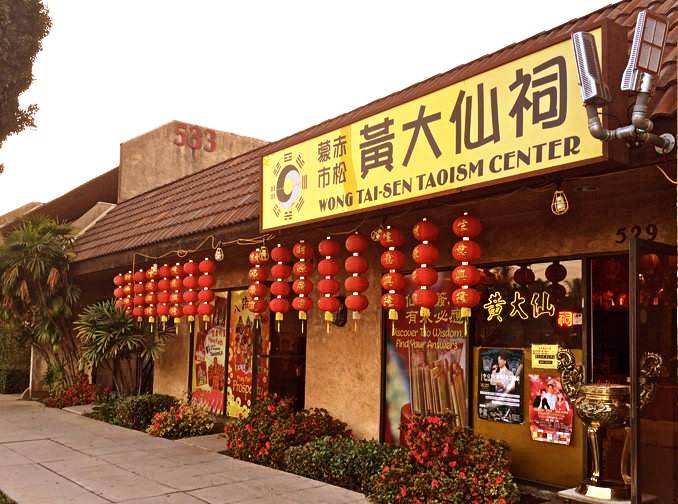 |
|
Phra Phrom - The Four Faced Buddha
Since 5,000 years ago, the disciples of Brahamana had paid homage to
Phra Phrom as their highest esteemed God in their religion. The
Brahamana (Hindu) religion is known to be one of the religions that has
the longest history. This religion was mainly symbolized by 3 major
Gods. Brahma, Vishnu and Siva, who form the main body of the
religion. The origin of this Trinity is that the Brahamana religion
believed that these 3 Gods gathered their powers to create this world
and sustain it.
Brahma - Creator of the World and All Things
Vishnu - Preserver of All Things
Shiva - Destroyer as Exists and Perishes according to Nature's
Cycles
In fact, in the records of Buddhist literature, Phra
Phrom belongs to the class of Devas and not Buddhas. Therefore, it would
be more appropriate to name him as the Great Brahma or the 4 faces God.
The significance of the 4 faces of the Buddha was to offer to help
people in need and grant them their wishes. |
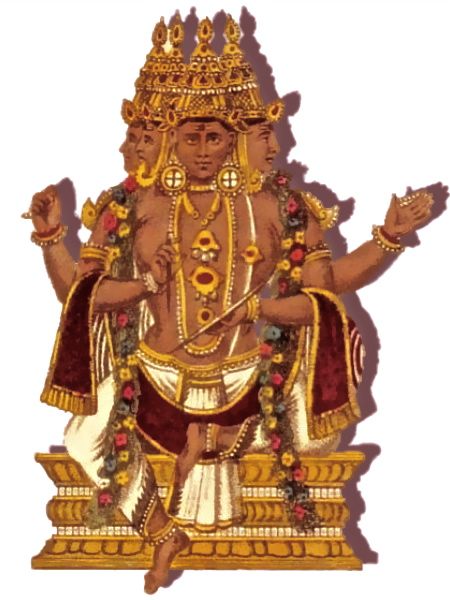 |
|